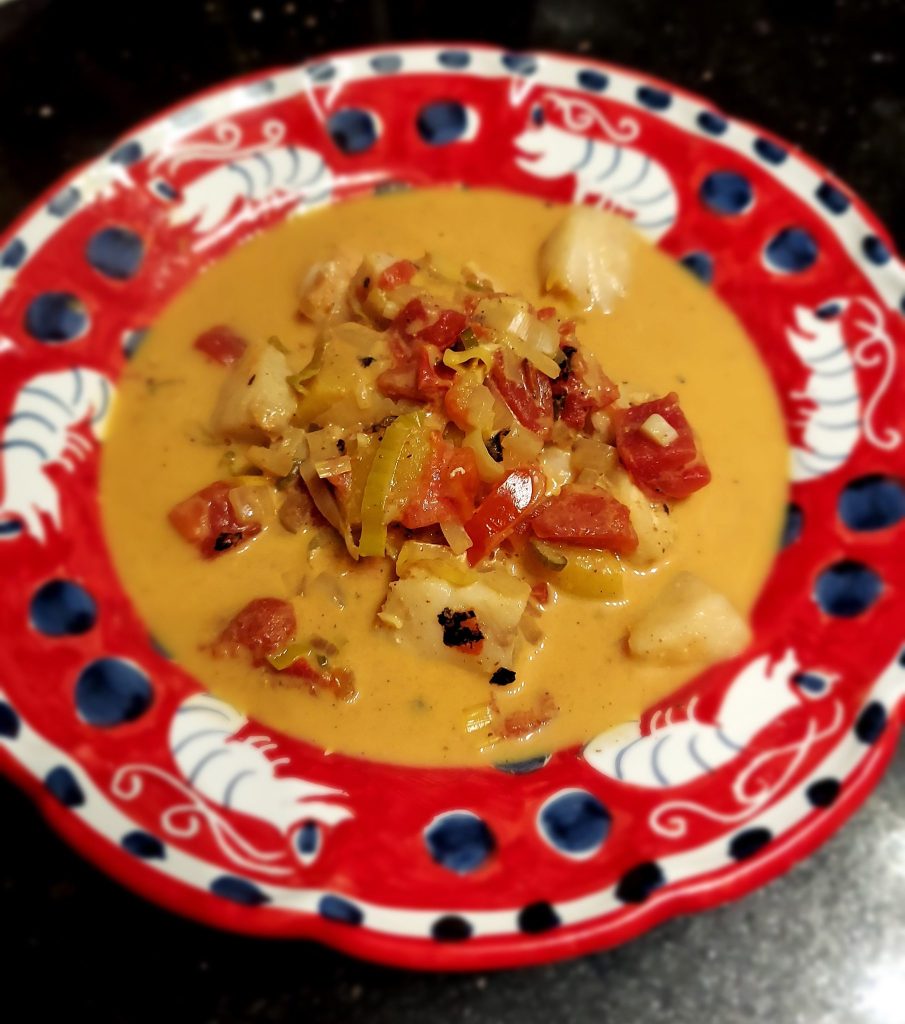The Faroese Daily Dish
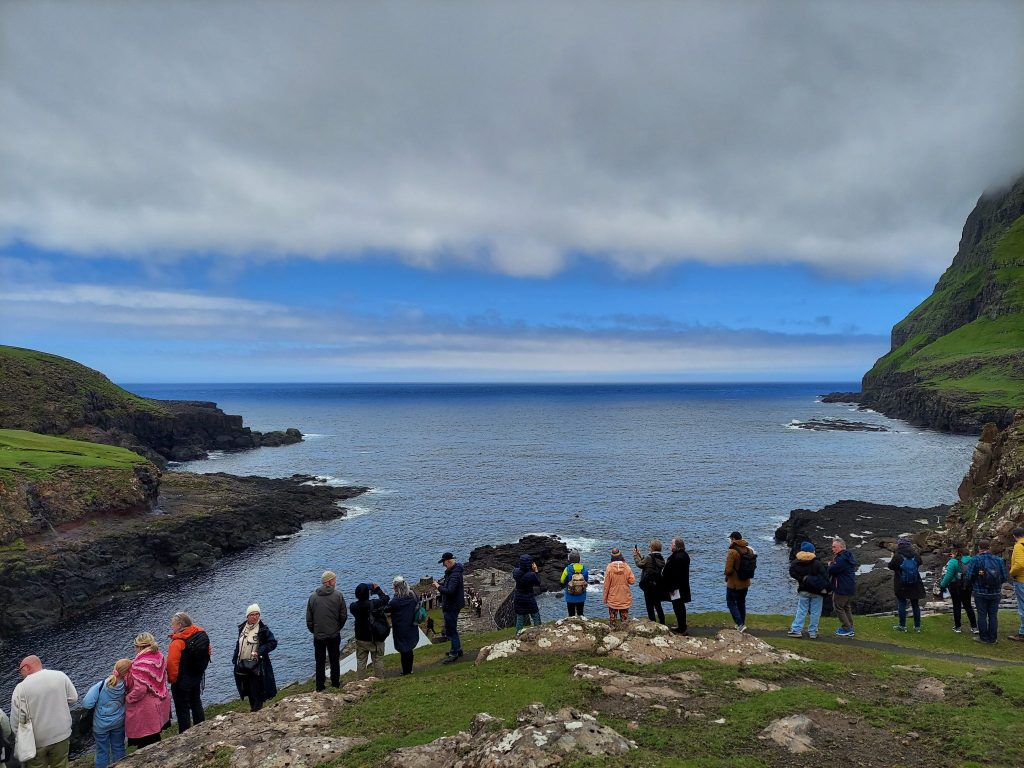
June 19 – Rain, Waterfalls, Sheep!
Whoa—32° C in New York City; 7° C at the Vágar Airport in the Faroe Islands. That was quite a shock to the system, not to mention the really bumpy landing because of the wind and our small Turboprop plane (let’s not talk about the fact that I couldn’t see anything outside my seat window, and that it took two landing attempts to get us onto the ground…). All of that initial discomfort fizzled as our taxi rode into Tórshavn. My stars! It was mesmerizing – the starkly majestic fjord landscape, the numerous waterfalls from the rain, the sheep on the steep slopes (LOTS of sheep), the colorful Nordic houses in the villages and the distant farmhouse. I knew I was in for a treat. But first, lunch, check-in, rest, dinner, and sleep, in that order. Gotta get into the zone before all the festivities begin!
*
June 20 – Jetlag is a beast…
Cannot be more thankful for the chaise lounge in the hotel room; the perfect thing to hop onto when—yawn—jetlag called… Also, finally sampled the very delicious sunchoke soup from the hotel restaurant, Hallartún at the Hilton Garden Inn (yes, but a completely different experience than their American counterpart!). It’s a local delicacy, and it also serves as the prelude to soup…lots of soup during the festival. (I love soup, give me soup.) Oh, and most importantly, I got my badge with a hand-woven lanyard made of Faroese wool. The badge was our festival pass, so I made sure it looked festive and appropriate. (Baa.)

*
June 21 – More Rain, An Unofficial Opening, and Getting Familiar with Tórshavn
The evening of the unofficial festival opening concert was also our first venture into the old town center of Tórshavn. We were quite a bit wet from the rain, almost got lost figuring out which winding path was the correct way downtown, and had a little trouble initially finding a place for dinner. But we found it—slurp!—a cute ramen joint called Suppugarðurin; just the right place at that time when we needed something hot to warm us up from the damp and chilly weather. (It’s the soup thing again, have you detected a pattern yet?)
We enjoyed our first taste of local Faroese music life at Reinsaríið, a cool and cozy concert hall with a bar attached. This seems to be the go-to downtown venue for all genres of music. It’s a fitting venue for the festival, one that presents all genres of music (I mean, we got yoik and contemporary classical and all that jazz), with engaging and dedicated performances from a wonderful mix of the multi-talented Faroese musicians and guest artists from Iceland, Denmark, Finland, and the UK.
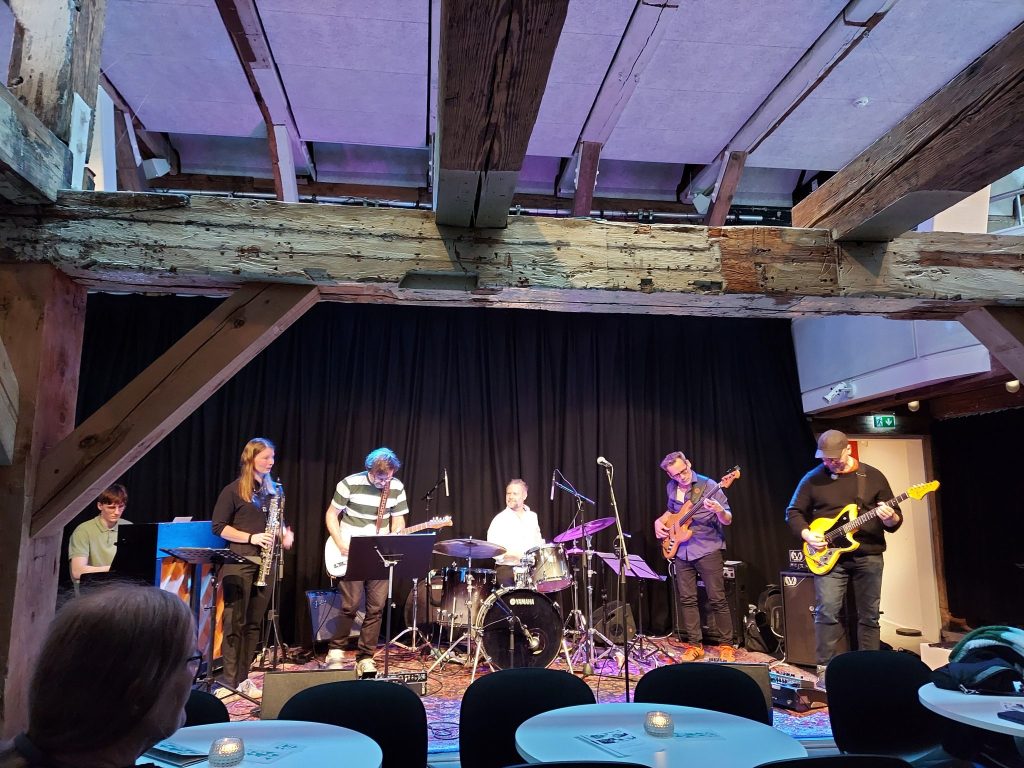
The Faroese jazz band, Norðurglóð, lead by bassist Arnold Ludvig with a line-up of fabulous local talents Leivur Thomsen (guitar), Jákup Tórgarð (piano), Heðin Z. Davidsen (guitar), Kristina T. Johansen (saxophone), and Rógvi á Rógvu (drums) (who will all make repeated appearances throughout the festival) opened the single-set concert with Gary Daley’s Hunger (2019), a submission from the ISCM Australian Section. The rest of the set were four original compositions by Ludvig.
The concert clocked just at 30 minutes, which left us ample time to head back to our up-the-hill hotel with a late evening detour around the sleepy neighborhoods, as we enjoyed glimpses of Faroese city homes side by side with farmhouses and free-roaming sheep. (This would also mark the beginning of my quest in taking a proper sheep photo. That night’s count? Sheep: 1, Trudy: 0)
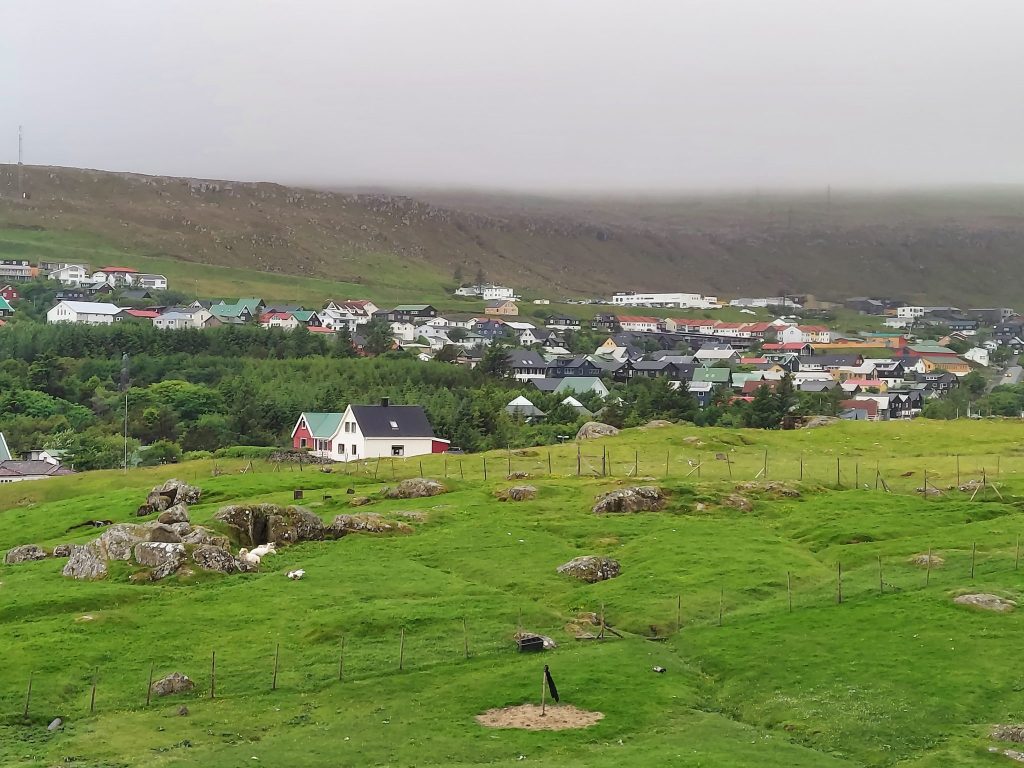
*
June 22 – Pre-festival Events Continue in Tórshavn and Rituvík, The Composers Collider, and Back to Reinsaríið
The morning concert at the beautiful historic Tórshavn Cathedral presented 6 works for solo cello and/or solo violin, performed by cellist Zoë Martlew from the United Kingdom, and violinist Sámal Petersen from the Faroe Islands. The program included two submissions from the ISCM 2024 Host Section-Faroe Islands by Edvard Nyholm Debess and Atli K. Petersen, and four other works by Isabel Urrutia (Basque Country), Zoë Martlew (England), George-Ioan Păiș (Romania), and Eloise Gynn (Wales). I must say, Zoë Martlew, fantastic player and composer as she is (I quite enjoyed her G lude which closed the program), also has such a great stage presence. Her cheerful and enthusiastic introductions before each work expertly guided the listeners what to expect in the following minutes with anticipation. Bravo!
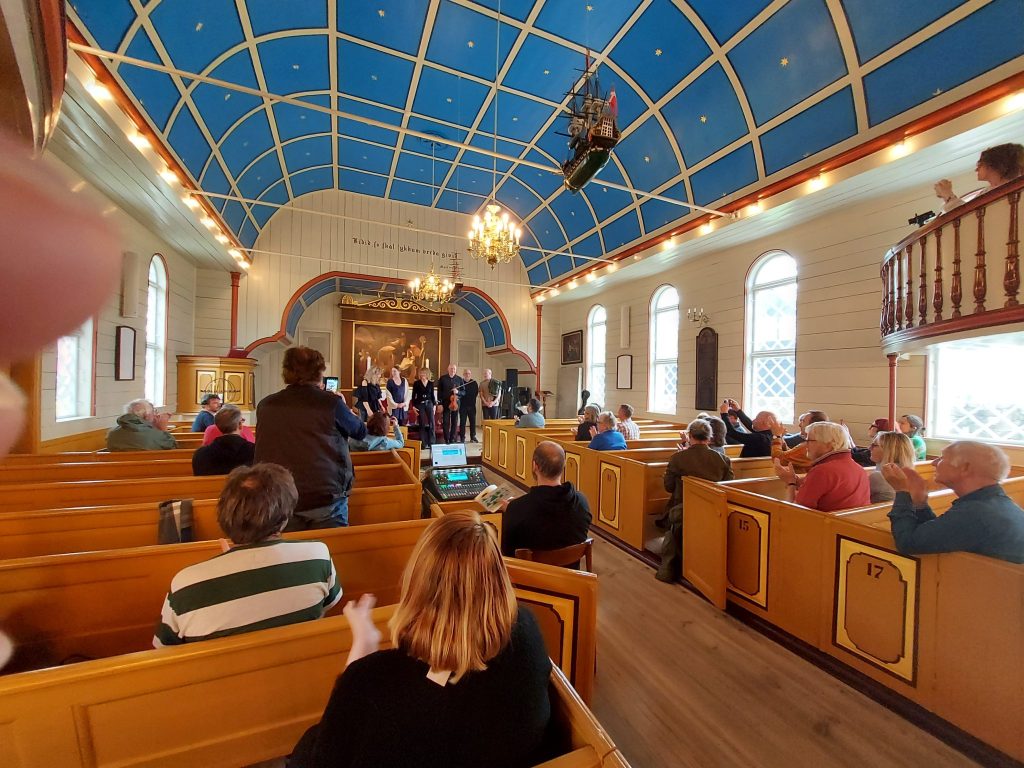
And, oh, I got an assignment! I was really happy to be invited to be one of the three judges for the ISCM Young Composers Award, and I was bright and ready for the first piece on the program (coffee can make that happen), Giant robots in a picnic basket by George-Ioan Păiș, which I have to admit might be one of the more-intriguingly titled works that I’d encountered!
We found our way to a local café (Kaffihúsið) for a quick repast before we took a walk towards the harbor, where we would catch the coach to go to Rituvík for our next concert, by way of the Eysturoyartunnilin. (More on that soon.) It was so delightful to get up close and personal with the charming historic homes with their signature grass roofs. As we gathered towards the harbor, this was also the first time that we saw many of our newly arrived delegates, looking rather windswept but nevertheless excited about the upcoming adventures (of all kinds).
The story of the Eysturoyartunnilin, the 12-km subsea tunnel and the largest one in the world with a roundabout was enough to pique my interest. I was also looking forward to hearing the work Æðr by the Faroese composer Jens L. Thomsen, commissioned especially for the tunnel. Alas, that was not meant to be, as the rather loud ambient noise from the bus almost drowned the whole piece out. Bummer. My ears were disappointed, but my eyes popped up by the installation (complete with custom lighting) surrounding the roundabout by the Faroese artist Tróndur Patursson. The installed cutout silhouettes represented the traditional dancers of Faroe Islands, and it was fascinating to circle a roundabout under the sea.
We arrived at the quaint seaside Rituvíkar Kirkja, on the island of Esturoy, for the concert performed by the Caput Ensemble string quartet. We listened to 6 pieces again (seemed like the magic number of pieces for every concert, quite nice, actually!), with Caroline Bordignon’s Incandescence (individual submission from UK)as the standout of the program. I was also quite intrigued by Kenneth Li’s Singing Our Swan Song of Serenity (Speaking of Satire) (ISCM Hong Kong Section), which was supposed to be capturing the sounds of animated Cantonese language and reprocessing those sounds through the string instruments. It was certainly not an everyday occurrence to hear reminiscence of the language you grew up with incorporated into a contemporary string quartet work in such a remote corner of the world!
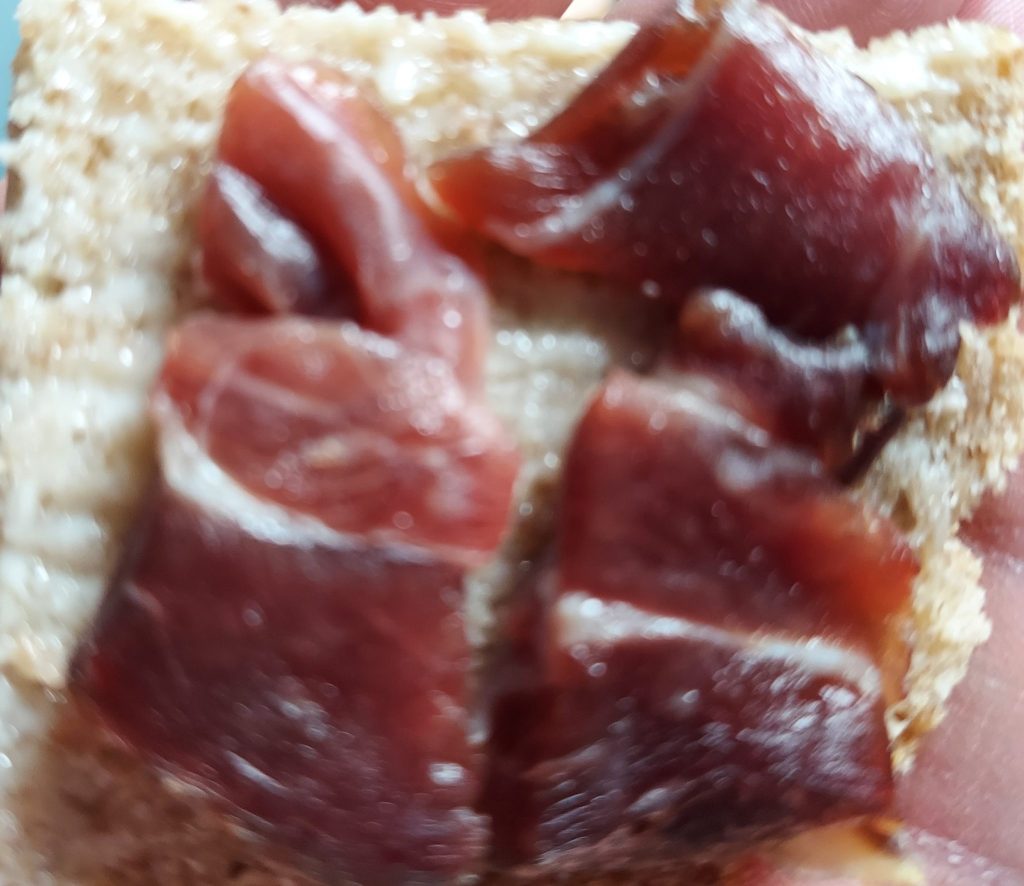
We were treated to an official welcoming reception (the first of quite a few!) inside the offices of Visit Runavík as we were hit by the cold rain again. This was special as we got to taste one of the most traditional dishes of Faroese Cuisine: fermented lamb. During the short welcoming speech, we were given a heads-up about the texture and the taste so that we were all prepared. I definitely tried it—kinda beelined towards it, actually—and it was definitely an acquired taste, but with a little glass of wine, it was an experience to remember. The welcoming festivities continued as Tórbjørn Jacobsen, the mayor of Runavík, showed us a Powerpoint presentation of the local history, sprinkled with colorful comments. It was interesting to learn about your host country, even when the presentation itself bordered on indulgence…
Once we returned to Tórshavn and sorted dinner, we headed to Finsen for the Composer Collider, which is always a fun event to meet the composers attending the festival, and to find out what they do. And, of course, it’s a really nice event to meet new friends, which is part of what ISCM WNMDs are all about! During this year’s iteration (which was organized by David Pay from Music on Main in Vancouver, Deborah Keyser from Ty Cerdd in Wales, and Magnus Bunnskog from the ISCM Swedish Section), we enjoyed the usual meet and greet and the get-to-know-your-new-friends-and-introduce-them-to-others (a.k.a. the essence of the collider!), all over crunchy snacks and drinks, including some interesting local brews from OY Brewing, such as the like-it-or-hate-it Svart Salt, which is a licorice porter. (In case you are interested to know – I like it!) And good times were had by all.
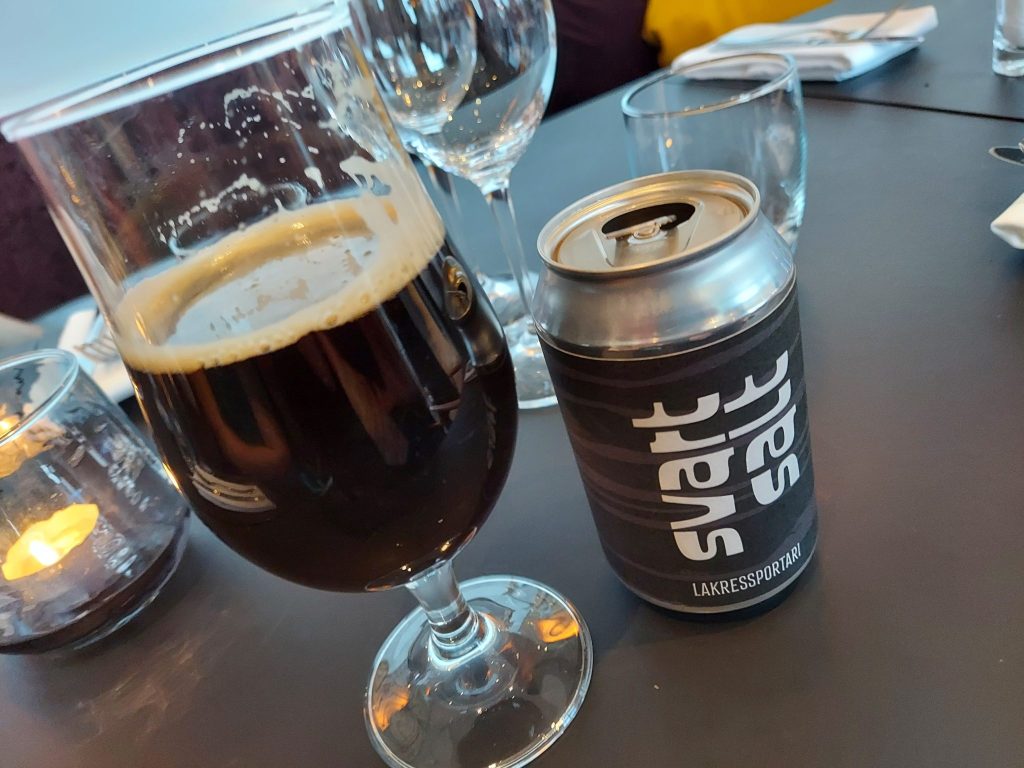
We returned to Reinsaríiðfor the final concert of the day, presented by Flytifólk, a Faroese band with a Klezmer-Balkan bent—(Daniel Rye (clarinet), Anna Hüdepohl (accordion), Torleik Mortensen (bass), James Goodwin (percussion)—presenting an “official” set of four works. A recent work called Now and Then (for Igor Stravinsky), by clarinettist Daniel Rye, incorporated excerpts of Stravinsky pieces that had been presented during the first ISCM festival in an improvisational format. Meanwhile, Oracle of May Winds by Rūta Vitkauskaitė (ISCM Lithuanian Section) easily transported me to a remote, windy landscape, which was actually the inspiration for the composer, who spent time in Scotland and was fascinated by the winds that she encountered there. It was certainly a bonus to hear her describing the work herself!
Just as we thought the evening concluded after the piece, we were told to sit tight, as there was a surprise second set waiting for us. And what a pleasant surprise that was! The band presented a “quasi-cabaret” as musical treats after the “main” portion of the concert, with really cool arrangements from works by composers whose music had been performed during the 1924 ISCM festival: Erik Satie and Kurt Weill. It was so fun!! I would also be remiss not to mention how mesmerizing it was to watch the contrabassist Torleik Mortensen perform! He embodied the music in such an infectious way, and it made you want to hop onto the stage and perform with him. (Well, no, I did not. Chicken.)
*
June 23 – The Official Festival Opening Day: Viðarlundin Park, “Small” Languages, and Yoik!
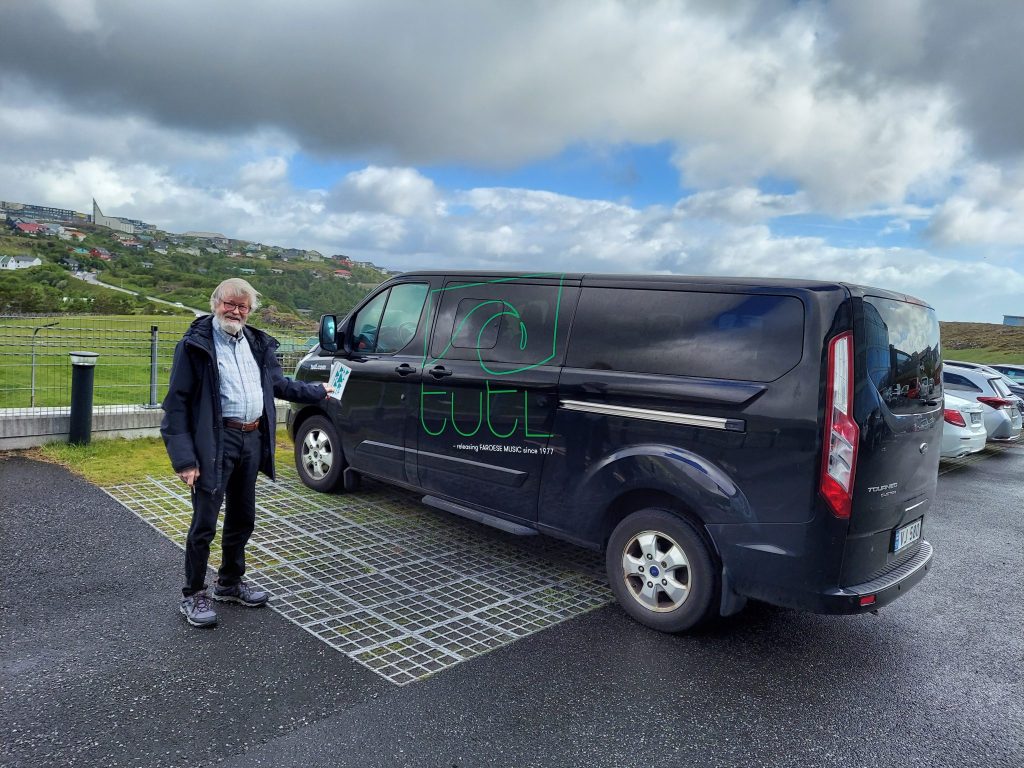
Exciting day as it was the official festival opening! The morning was slow, and I took the opportunity to enjoy the scrumptious breakfast offered at the hotel–because I’d soon need all that energy to make that trek from the hotel to Nordic House, where the festival opening concert was going to take place. But first, the wind. OMG, the wind!! Yes, we were warned by the weather forecast that the wind would be ferocious, but I wasn’t quite prepared for that level of wind blowing while I was trying to walk that relatively short distance through the open air. A few times I had to stop and hang onto a lamppost or something to let a particularly strong gust pass through. I was so thankful to finally get indoors. (I was not as windproof as the hardy sheep who were just munching and strolling leisurely as ever. Yeah, yeah, I know they are used to it. And, no, I definitely didn’t take a picture.)
The opening concert took place in the main concert hall. Before the music began, there were several welcoming speeches for the festival delegates as well as the Faroese ticket holders. Speeches were given by Faroese officials as well as ISCM President Glenda Keam, and we were introduced to the full co-artistic directing team for the 2024 World New Music Days. After we were all properly welcomed, Faroese pianist Mathias Kapnas began the concert with an excerpt of Reflections of South Africa by Chesney Palmer (ISCM South Africa Section). (We will get to hear the piece in its entirety later in the festival.)
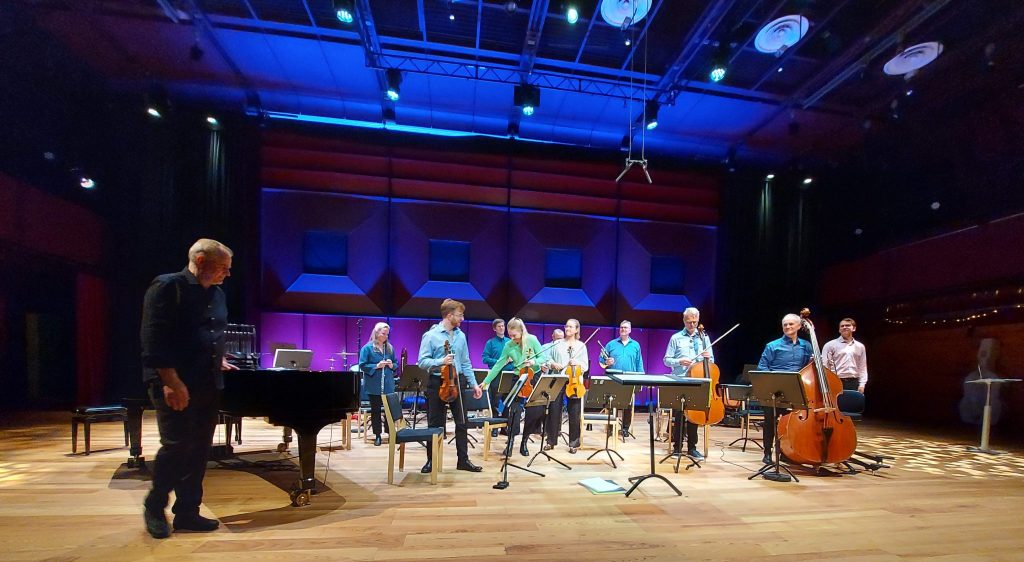
The Caput Ensemble took over the stage and began the concert of seven works for chamber orchestra. The concert opened with festival co-artistic director Sunleif Rasmussen’s Surrounded, followed by chamber orchestra works submitted from the ISCM sections representing Shanghai, Slovakia, Nanning, Lithuania, and Norway, as well as a submission from the Prague Spring Festival. Blast by Zhong Juncheng (ISCM Nanning Section) and Ouroboros by Martyna Kosecka (ISCM-Norway) left the deepest impression on me.
We then got to stretch our legs for the outdoor portion of the day. We walked towards Viðarlundin Park, a lovely respite from the more bustling parts of Tórshavn, which also housed the compact but well-curated National Gallery of the Faroe Islands on one end of the park. The open-air concert featured four composer-performers in three different locations as we walked through the park. ISCM Faroe Island Section’s Heðin Ziska Davidsen, wearing his composer hat, presented a 6-channel sound installation entitled Ringar í Vatni (Rings in Water) (we’ll get to see the many faces of Heðin throughout the festival) by the memorial statue as we were guided towards it by Kelvin King Fung Ng (individual submission from the UK), who performed his Brief Version of Seoljanggu – 0, I, II directly outside the art museum and then led the way.
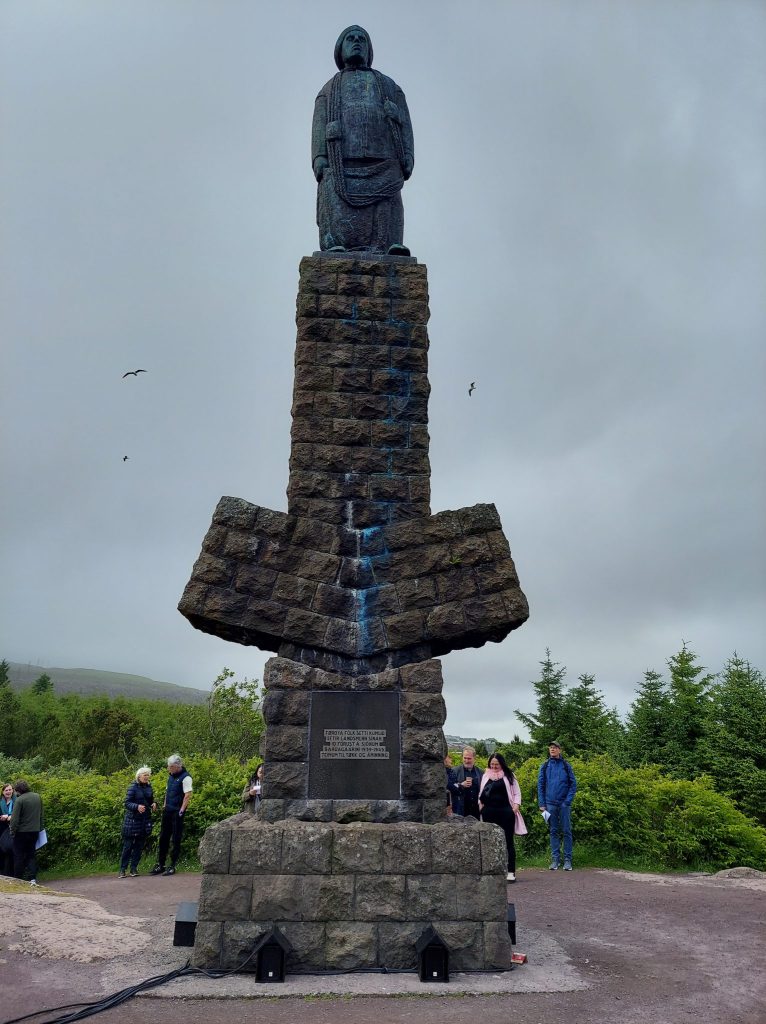
We continued to walk through the park, passing by the duck pond with its highly amusing inhabitants, to the lawn by the other end of the park, a piece called Tað skeiva stykkið í Pisu for trumpet, trombone, and electronics, written and performed by Johan Hentze and Andras Olsen (ISCM Faroe Islands Section). Open-air installations were present throughout the festival with several works set up in various locations around Tórshavn for specific periods of time. We stopped by the Gallarí Havnará to hear a brief introduction to the installation by Stéphanie LaForce (ISCM Wallonia-Brussels Federation Section) called EOLIEN-SONORE – The sound of the wind, a very apt title for the strong winds that day. We continued our journey down to enjoy a local catered meal of Faroese dishes, with roasted salmon and roast pork loin being the double stars of the meal.
After the warming hearty meal, the next concert was right across the street at the Tjóðpallur Føroya, with a program of works featuring texts in “small languages” (languages with only a small number of speakers or which risk extinction). Before getting to my seat, I had a chance to visit one of the installations, Music for PlayStation by Jesse Austin-Stewart (submitted by the ISCM New Zealand Section). (I think I might have been the first person to interact with the installation at this location!) The installation is triggered through a PlayStation DualSense controller. The composer writes: “These tracks can only be felt, not heard. This music has been designed so that audiences of all types of hearing, whether hearing, hard of hearing, or d/Deaf, can engage with the music on equal terms.” I tried hitting all the different buttons and focused on “listening” through the tactile motions while contemplating the rationale behind the work.
Charlotte Seither’s baff (ISCM German Section) opened the program, an athletic vocal work with sounds and syllables emulating the Pfälzisch dialect, was expertly performed by Berlin-based Faroese soprano Birita Poulsen. Sunleif Rasmussen came on stage to speak after the piece, informing us the sad news that the composer for the next piece, Bjarni Restorff, passed away recently. We all observed a minute of silence in memory of his untimely death before Birita Poulsen returned to the stage with guitarist Ólavur Jakobsen to perform Gittarin for soprano and guitar with text by Federico Garcia Lorca (ISCM Faroe Islands Section). The program continued with works by Unn Paturson (Wicked fysikk, another host section submission), Chiu-Yu Chou (Ocean Sailing; ISCM Taipei Section), and Amble Skuse (Chapels with Splendid Glass Windows, Scottish Music Centre submission). Skuse’s piece, a string quartet inspired by a text in middle Welsh which was recited before the performance, was the only work on the program that did not involve singers. The final piece was a joint commission by the ISCM WNMD Faroe Islands and the Nordic Music Days Scotland. Unfortunately, the composer of the piece (Annilaanganeq qilammit nakkaalavoq), Arnannguaq Janna Porsborg Gerstrøm from Greenland, was unable to travel to Faroe Islands for the concert because of illness. At least we could experience the beautiful performance of the work. A shoutout to Esther á Fjallinum who recited all the texts before the start of each work.
It was a long day, but we had one more show to attend. Thankfully it was right next door, back at Reinsaríið, this time for WNMD 2024 co-director, Faroese composer Kristian Blak’s own group, Yggdrasil: Angelika Hansen (violin), Heðin Ziska Davidsen (guitar), Kristian Blak (piano), Mikael Blak (bass), Per Ingvaldur Højgaard Petersen (drums). Yggdrasil is a Faroese jazz ensemble inspired by folk music from the Faroe Islands, Greenland, Sápmi, and many other places. The band presented Kristian Blak’s Porkerisvatn, a suite in eight parts that was commissioned by the National Gallery of the Faroe Islands to create music for one of the paintings in their permanent collection of the same name by the Faroese poet and painter William Heinesen. Let me tell ya, that was an electrifying concert! The music, juxtaposing folk, jazz, progressive rock, and yoik, definitely brought the house down. I was a tired but happy little clam as we made our way back to the hotel for the much-needed sleep. (A night cap with friends will have to wait.)
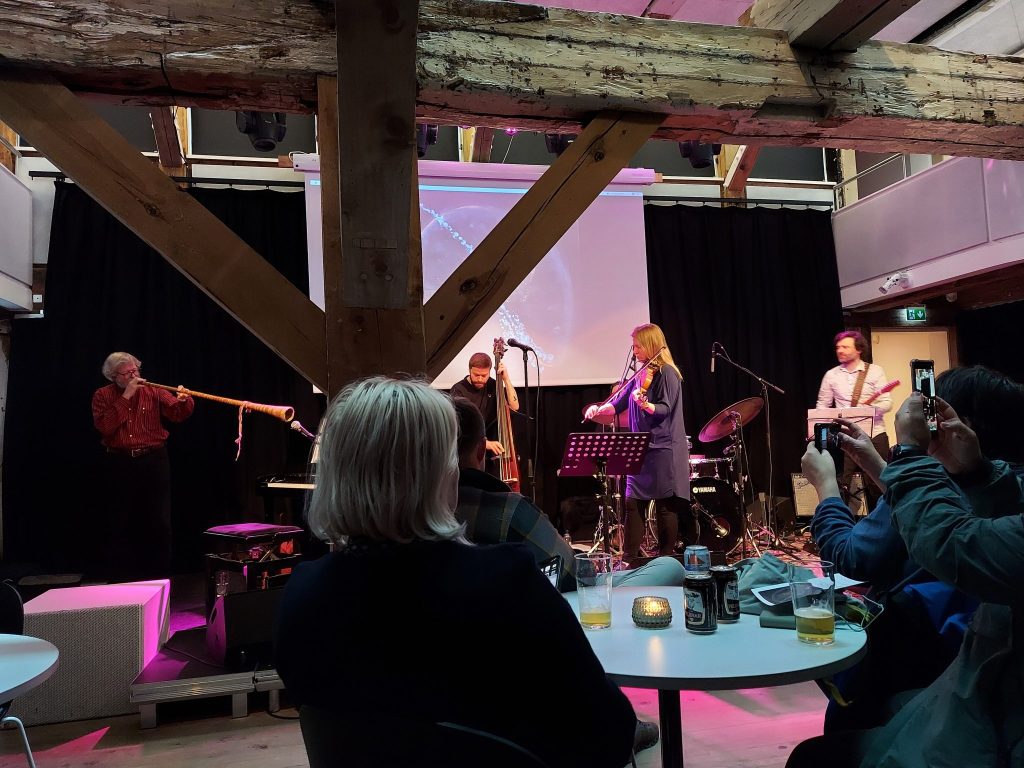
*
June 24 – The First YCA Jury Meeting, Tórshavn Music School, An Excursion to Sandoy
My day of music didn’t begin until after lunch on June 24, so I took some time after breakfast to catch up on some work in my cozy hotel room. I was also excited to have my first official meeting with my fellow YCA judges—Magnus Bunnskog (Sweden) and Deborah Keyser (Wales). We had already listened to a few pieces, and it was good to check in as a group to talk about the works, and also to set some parameters that would inform the rest of our panel meetings. We gathered at the Nordic House before the 3pm concert. The meeting went without a glitch, and we were extremely happy to find ourselves working very harmoniously as a group while still maintaining our “independence” as individual panel judges. We certainly started our official YCA duties on our collective right foot!
We were ushered into Klingran, a bright and semi-open performance space for a concert of chamber music. The program opened with young Faroese composer Bjarni Blaasvær’s La Follia, inspired by the well-known tune of La Folia, followed by a solo clarinet work, Within the Fairy Ring and Out of It, by Per Nørgard (ISCM Honorary Member), Out of Breath, a sonorically interesting work for violin, cello and electronics by Marianna Liik (ISCM Estonia Section), a concise work for Seitara Shibaro entitled A letter from Grandchild, and Svetlana Sávic’s Temporal Variations (ISCM Serbian Section). But the piece that stood out for me the most was the final work on the program, Lyre, for violin, cello and piano by Victoria Kelly (ISCM New Zealand Section). The beautifully contemplative work gave a satisfying conclusion to the concert, before we made our next move across town for the Lapland Chamber Orchestra concert at the Tórshavn Music School.
The day remained rainy as we arrived, with ample time to find our seats inside the sleek-looking performance hall. The program again featured six works, performed by the string section of the Lapland Chamber Orchestra, led by music director John Storgårds. It was an intensely beautiful concert with all shades of musical colors imaginable. The performance began with two works for smaller string ensembles, Eric Egan’s in some or other Oasis | (i en eller annen Oase) (ISCM-Irish Section) and Vel op før dag by Pauli í Sandagerði (ISCM Faroe Islands Section). The next four pieces were scored for a string orchestra, beginning with Dissolvenza by Nataša Bogojević (ISCM-Serbian Section), and followed by three other works that were on the YCA listening list: The Infinite Mirror II by Maciej Kabza (ISCM-Poland Section), was birgst du so bang dein Gesicht? By Carlos Brito Dias (ISCM-Portugal Section), and the last piece on the program, Raimonda Žiukaitė’s 1000 Mouths (ISCM-Lithuania Section). It was impossible to rate which one I enjoyed the most, and it would not be fair to the composers at all. So, all I can say is that this concert was probably at the top of my list for the festival!
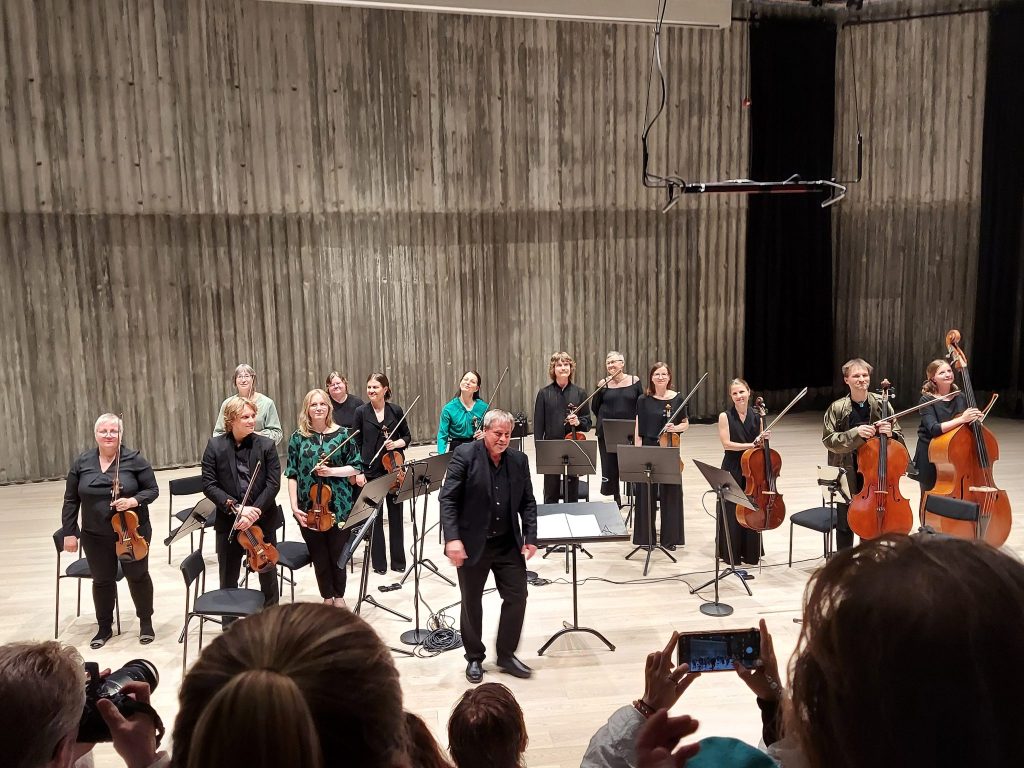
We hopped back onto the bus for our excursion of the day/evening, a trip to the island of Sandoy for an intimate concert at the Sandur Art Museum. But not before passing through another subsea tunnel first, to be serenaded by Sunleif Rasmussen’s composition for car radio and tunnel, commissioned especially for the Sandoyartunnilin. There was yet another fun surprise while we were en route to the tunnel, this time in the form of vodka. Running between the two buses that were carrying all of us to our next destination, Sunleif introduced to us to Dánial Hoydal of the Faroe Isles Distillery, who in turn shared with us the intriguing story behind their prize-winning North Atlantic Subsea Vodka, distilled with the pure subsea level water tapped from a secret access somewhere in the subsea tunnel. We all got to sample it as we listened to the story. The vodka warmed us up as we were driven through the tunnel, enjoying Sunleif’s piece.
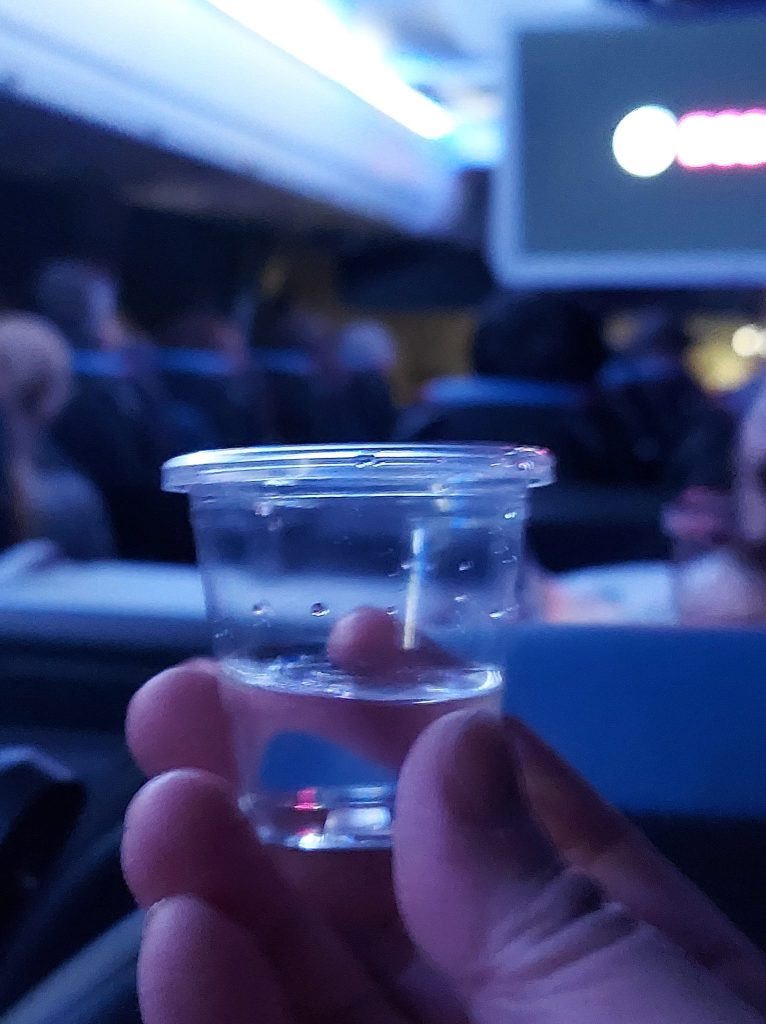
We were told that they would split us into two groups because of the intimate size of the Sandur Art Museum. As the first group headed towards the music, we were ushered into a community hall to enjoy a delicious meal of baked cod, a fixture of the local cuisine which would continue to make numerous appearances as our festival continued. It was lovely to sit down and chat with our friends as we enjoyed the appealingly rustic dinner. As we wrapped up our meal (literally speaking, the fish was baked in parchment paper), it was our turn to experience the music as the first group trickled in, no doubt looking forward to a well-anticipated dinner.
The two-level Sandur Art Museum was compact, and it was clear as we walked in why we were split into two groups. We were able to study some of the artwork on the wall before the concert began. It was a short concert of four works, the first being a reprise of Chesney Palmer’s Reflections of South Africa, this time in its entirety and performed again by Mattias Kapnas. Kapnas continued with a performance of the 2nd movement of Kristian Blak’s Piano Concerto (co-composed with Kapnas), joined by percussionist Jan Rúni Poulsen. The two composer-performers finished the program with two short works for piano and percussion, Bei and Budapest.
It was time for us to make our way back to Tórshavn, but not before trekking towards our bus through the sleeping village in the low light and rainy grayness on this particular summer night. I share with you all here one of the striking photographs that I took at roughly 10:24pm: a red farmhouse, green pasture, retiring sheep (not counting this photo as a successful sheep shoot yet!), and the starkly towering mountains in the backdrop.
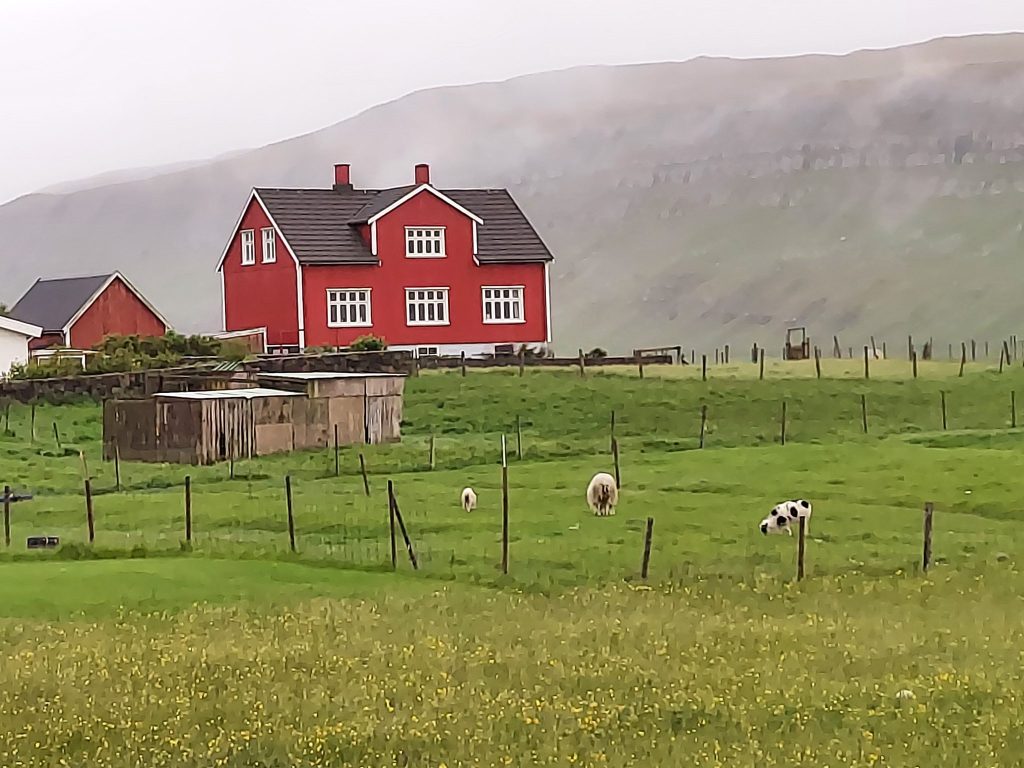
*
June 25 – A Stroll Into Town, A Multi-Channel Speaker Concert, and Another Late-Night Club Show
My first activity out of the hotel today was to roll into town for lunch. Wanting to explore a different route downtown, I took a new route that led me past Hotel Brandon, where some of our delegates were staying, and a generally faster route downtown. I passed by some farmhouses on the road, swatted away one too many midges, and there was nary a sheep in sight. (Boo.) Lunch was a delight at the lovely Scandinavian restaurant Bitin (which reminded me of IKEA–sorry, can’t help it), with their nice selection of modern Nordic Smørrebrød and yummy lemonade. It was also just a few minutes away from Finsen, the concert venue for the multi-media concert, which I was heading towards for the first of the two shows.
Again, there were six works on the program, including a number of pieces on my YCA listening list: Alexander Tillegreen’s Phantom Streams (in 5 movements zyklus I) for 6 channel audio (ISCM Denmark Section), Bekah Simms’s Jubilant Phantoms (individual submission from the UK; the sound of the just-intonation accordion reminded me of the sheng, the Chinese mouth organ), and Anuj Bhutani’s East wind melts the ice (a Florida International University submission). It was also nice to learn about Libby Fabricatore’s Midnight Observations at Central Sound Buoy (an individual submission from the United States). There wasn’t any rain that afternoon, so it was a good opportunity to take a walk back to the hotel for a break before the evening activities began.
We returned to the Nordic House for the second installment of music by the Lapland Chamber Orchestra, this time with the full band. John Storgårds was at the helm again, conducting another 6 chamber orchestra works, including the world premiere of Sunleif Rasmussen’s Chorals and Dances, a compact piano concerto by Victoria Frances Young (individually submitted from the United States), with Anna Laakso as the soloist, Cardboard by Tom Irvine who also doubled as a vocal soloist (Scottish Music Centre), as well as works by Haimoni Balgava (ISCM Slovakia Section), Janco Verdain (ISCM Netherlands Section), and Kristian Blak. A big round of applause for the band for such high-level performances!
It wouldn’t be a proper World New Music Days without late-evening shows at cool clubs. We moved back downtown to Blábar to attend the first of the three shows.
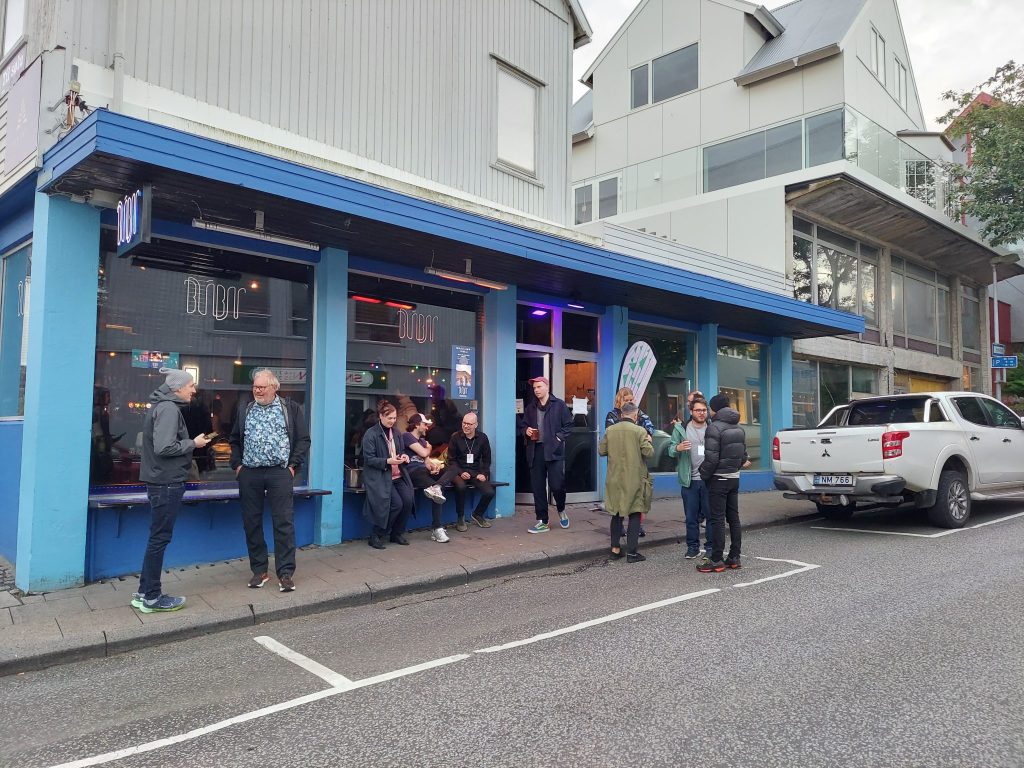
With a glass of wine in my hand, we settled in snugly at our table for the two short sets performed by The Network Ensemble. Electronics and multi-media works were the features of this show. I was particularly struck by Andreja Andrić’s Concert for Smartphone Network (individually submitted from Denmark) with its eye-catching accompanying video, and Lauren Sarah Hayes’ The Accusations That Are Confessions (submitted by Florida International University) with the composer performing the live electronics, which concluded the music events for the day. But wait! My evening ended much, much later, as we proceeded to spend some really lovely time catching up with friends at the hotel lobby while the sky turned from low-light gray to deep-blue as we chatted into the wee hours.
*
June 26 – More Eysturoy Adventures, Back to Blábar
June 26 was a very, very memorable day as we travelled back to Esturoy. I’ve attended several ISCM World New Music Days festivals, but this might be the first one where sightseeing was deliberately built into the day. And I can totally see why! Who wouldn’t want to see the breathtaking landscapes as we traveled to various venues to continue on our music journey? My quest for a perfect sheep picture (no, sorry, ovine count to date: Sheep: Still 1, Trudy: Still 0) was replaced by how fast I could click my phone camera to capture that perfect angle where the fjords interlocked. It was quite amusing to see my fellow travelers were all doing the same thing. Nature wins.
On our way to the first concert, our buses stopped in the middle of a mountain, and we were all told to get off the bus. The reason? This…
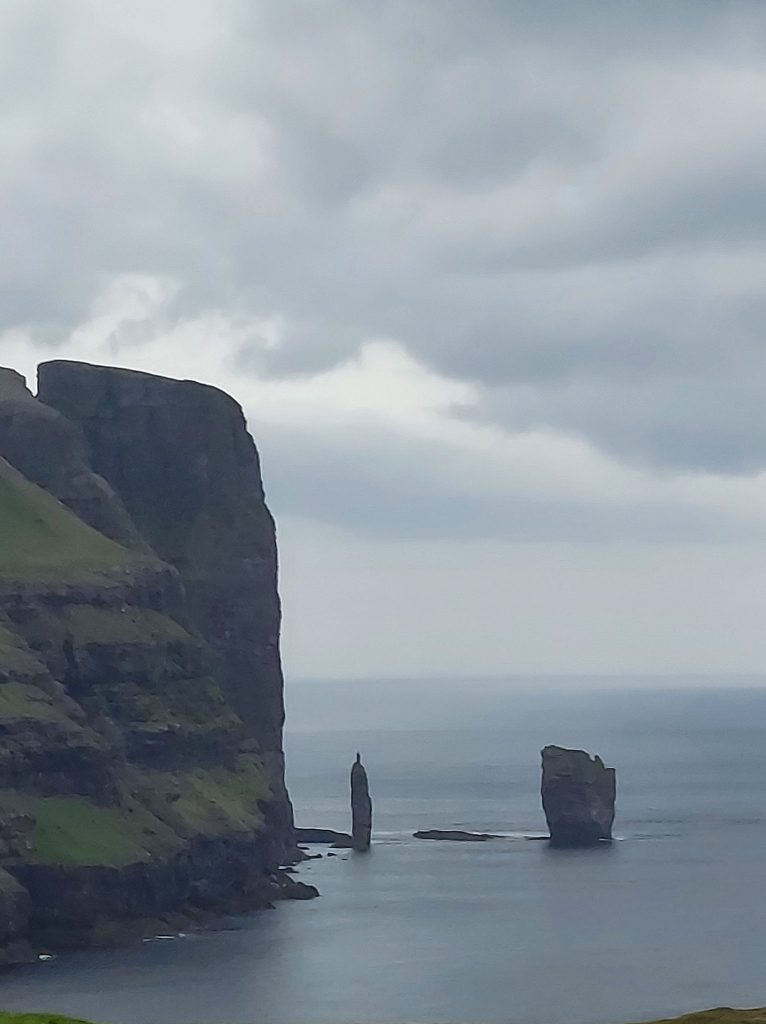
Here’s a description of the folklore in case you need a refresher; it is much better than me attempting to be a travel writer. It was misty and quite cold, but that didn’t damp our excitement as we all took turns making our snapshots and posing with friends for selfies. Alas, we had a schedule to keep so after several minutes of oohs and aahs, we were back on the buses and off we went for our next stop: Gjógv.
The village of Gjógv is situated on the northeast tip of Esturoy. We only had a few minutes to admire the view looking out from the bottom of the fjord before we were guided uphill to what looked to be an opening to somewhere. Well, that somewhere led us to a flight of stairs, rather treacherous I might say, until we arrived at the bottom of a narrow ravine. The stunning scenery served as the beautiful background for an improvisatory concert for various horns (trumpets, saxophone, trombones) with electronics.
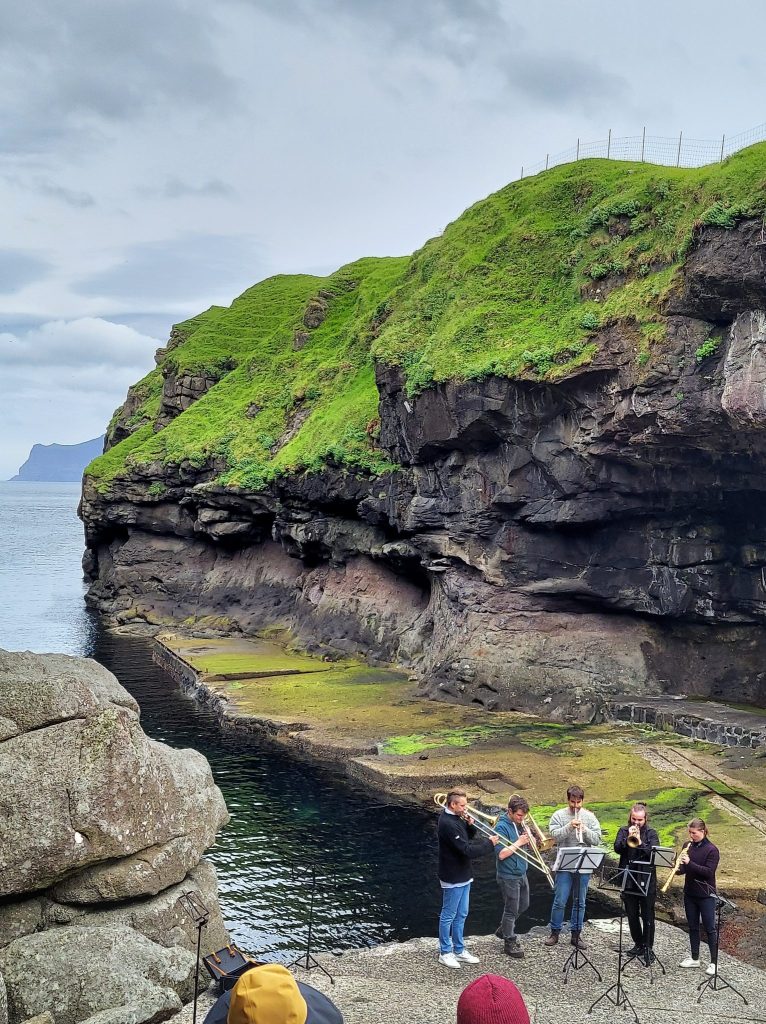
The breeze carried the sound of the horns, amplified by the natural acoustics of the ravine, resonating gently around us during the short set. It was magical. Much too soon, the set was over and we traced our steps back to our bus, with me chanting quietly internally: “OMG, OMG, do not fall flat on my face and make a spectacle of myself” as I climbed gingerly up the slightly slippery steps.
We continued our journey on our buses with more spectacular scenery along the winding country roads (and prancing sheep on steep cliffs, a curious sight to behold), until we arrived at the village of Funningur, on the northwest side of Esturoy. This was yet another charming little village with the hallmark look of colorful paints and grass roofs. We were heading towards the Funningur Kirkja, famous for its wooden etching interior. The church was tiny; our entire group easily filled up the space. We were treated to a wonderful concert of mostly Faroese traditional instrumental and vocal music featuring the fabulous Kári Sverrisson (voice) and Alvi Joensen (guitar), as well as Đỗ Hồng Quân’s The Sound of the Jungle for 3 flutists (a Vietnam Contemporary Music Centre submission), performed by the Floytu Trio. It was a lovely concert showcasing the more “traditional” offerings of this festival, beautifully enhanced by the perfect acoustics of the venue.

Nature called after the performance as several of us were trying to find the facilities. As we located the much-needed space (phew, and oh, the line, hahaha), we didn’t realize we actually arrived at our next destination, a little community center where some of the luckier ones among us got to witness and participate in a traditional dance demonstration. It was just too small a space for too many of us; some of us with longer arms stuck their phones through the window to make videos of it. (Spoiler alert: I did not.) My slight disappointment was soon alleviated as we filed into two school rooms that doubled as tea rooms, as we gratefully sipped a restorative cup of hot tea and nibbled on a couple cookies as a pick-me-up. And then, well, time to get back to Tórshavn for a little dinner break before our 9pm concert at Blábar. What a wonderful day.
I have to admit I was quite a bit tired as I walked into Blábar, but I was excited when we found our seats very close to the stage, so that we could observe the duo Hettarher in close action. That was extremely welcoming as I was excited to see Torleik Mortensen on stage again (fan girl, fan girl), this time also wearing his composer hat, performing his own composition, Unity of Opposites, which he co-wrote with cellist Andreas Restorff. It was great to hear Andreas Restorff perform again too after the chamber music concert at the Nordic House a couple of days ago. He performed several works for solo cello and electronics, including Shades of Light by Anneliese Von Parys, a work initially submitted by the ISCM-Flemish Section for the 2023 WNMD edition which was finally played at this festival. It was nice to be back at this cool club this evening, but the bed was really calling after a long day with lots of excitement and excursions, so off to the hotel we went to get some much-needed rest and see what the next day might bring.

*
June 27 More Music at Nordic House, Sondheim and the Organ in Eysturoy
The YCA judges met again before the first concert of the day at the Nordic House. We remain an extremely harmonious and efficient group; sharing our opinions on each of the works that we have listened to so far, evaluating our own comments as we compare them with the ones from the rest of the group. If only all judging panels worked so seamlessly! We finished our discussions with a few minutes to spare as we ambled back downstairs to join our friends for another chamber music concert at the Kligran, this time performed by EKA from the Faroe Islands: Kristina Thede (saxophone), Aksel Remmel (piano), Ernst Remmel (trumpet). Pianist Askel Remmel opened the concert with Kvöldtónar (Sounds of evening) by Gísli Magnússon (ISCM Icelandic Section), a short five-movement piece that was sparse and haunting, followed by another piano solo work by Teitur Lassen, Y Arpeggios, offering a completely different sound world of—yes, you guessed it—reverberating arpeggios. The program continued with a work by Ukrainian composer Valentin Silvestrov entitled The Messenger, Anna Katrin Ø Egilstrøð’s Viðljóð, and In ignota terra by Andras Ellendersen, all submissions by the Host Section.
Not a moment to spare as soon as the concert was drawn to a close, as we boarded the buses waiting right outside of the Nordic House to take us back to Eysturoy, this time to the eastern village of Fuglafjarðar. Before the official concert, we were invited to another reception for a welcoming glass of bubblies, and an endearing local group consisting of a singer joined by her brother on contrabass and a friend on piano performing renditions of American musical numbers, including Dot’s aria from Stephen Sondheim’s Sunday in the Park with George.
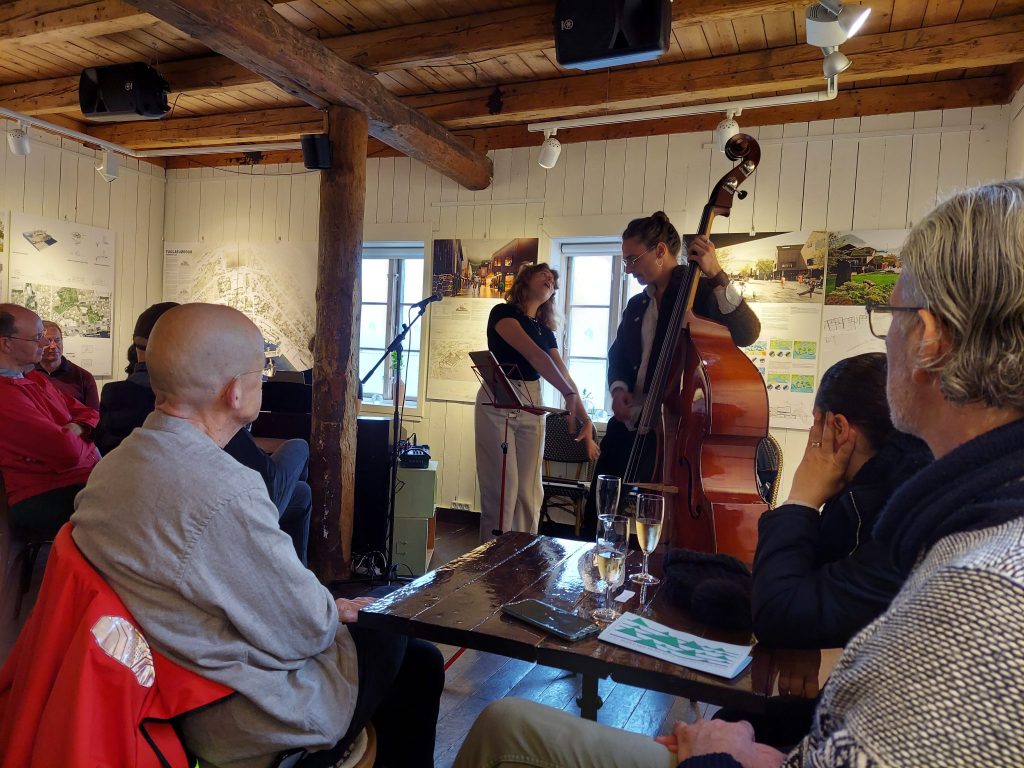
After the utterly delightful performance, we moved towards a nearby hall to enjoy another locally catered dinner. We sampled another noted dish of Faroese cuisine, the Faroese fish soup. It was warm and delicious and much needed as it was yet another damp day. We also enjoyed another local vocal talent serenading us during our dinner.
We trekked uphill after dinner for the evening’s main event, a concert of solo organ music at the Fuglafjarðar Kirkja. Hans Hellsten, the organ soloist of the evening, performed a program of 6 works, with three of them submitted by the Host Section and written by Eli Tausen á Lava and Kristian Blak, and the rest of the program were Das Wiedersehen/The Review by Ana Szilágyi (submitted by ARFA, Romania), Magma by Samuel Hvozdík (ISCM-Slovak Section), and Étude 7 by S. Andrew Lloyd (submitted by Stephen F. Austin State University). It was an interesting concert to say the least; its significance will become apparent sometime later…
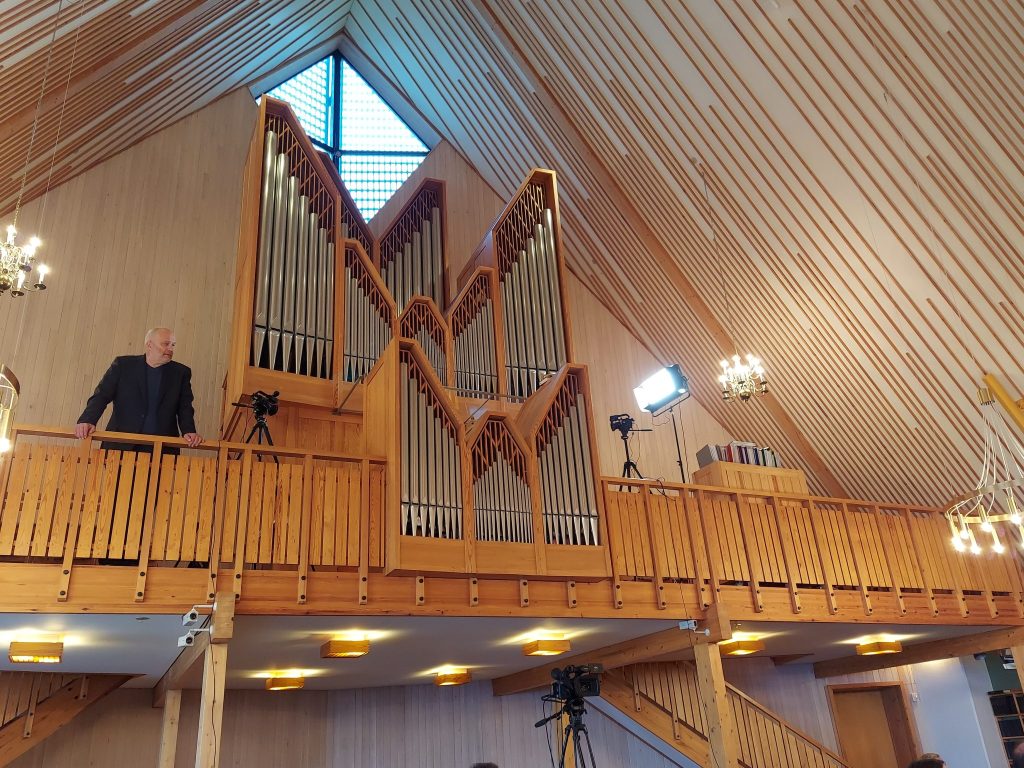
We had another opportunity to ride through the Eysturoyartunnilin and checked out the roundabout and the installation again as we were en route back to Tórshavn. As we got off the bus by the Hotel Brandon, I had a choice of walking back downtown for the third and last installment of concerts at Blábar, or to take some time to chat with friends whom I haven’t had much of a chance to connect with during the festival. The people factor won as I settled around a table, glass of wine in hand, chatting merrily with friends while reminding myself that I’ve heard half of the program several nights ago at the unofficial opening concert at Reinsaríið.
*
June 28 – Art and Installations, The Penultimate Concert at the Nordic House, Klasvík
In the morning, there was finally some time to check out the National Gallery of Faroe Islands. We only took a glimpse at the gallery when we were attending the open-air concert several days ago, but now we had a little time to explore the museum. It was small but quite well curated, with a permanent collection of paintings and sculptures spanning across several rooms. There were, of course, quite a number of art works by William Heinenen (including the one that Kristian Blak created music for), but there were also other works by other Faroese and Nordic artists. On the other side of the gallery are a couple of special exhibitions of contemporary Faroese artists, including a fascinating one called “Body”, with artworks examining the body in familiar and new ways. It was time well spent!
I decided to make some time to check out the other installations as we took a nice walk through Viðarlundin (such a lovely park!). But first, I had a mission—I need to go find a cookbook, as I collect and cook from them. (Those who know me well would know that I LOVE to cook and to explore different cuisines all over the world as it is such a wonderful way to learn about different cultures!) I was able to pick up the one cookbook available in HN Jacobsens Bókahandil. Of course it is only in Faroese. Well, at least there is Tradukka.com! Another exciting culinary adventure awaits.
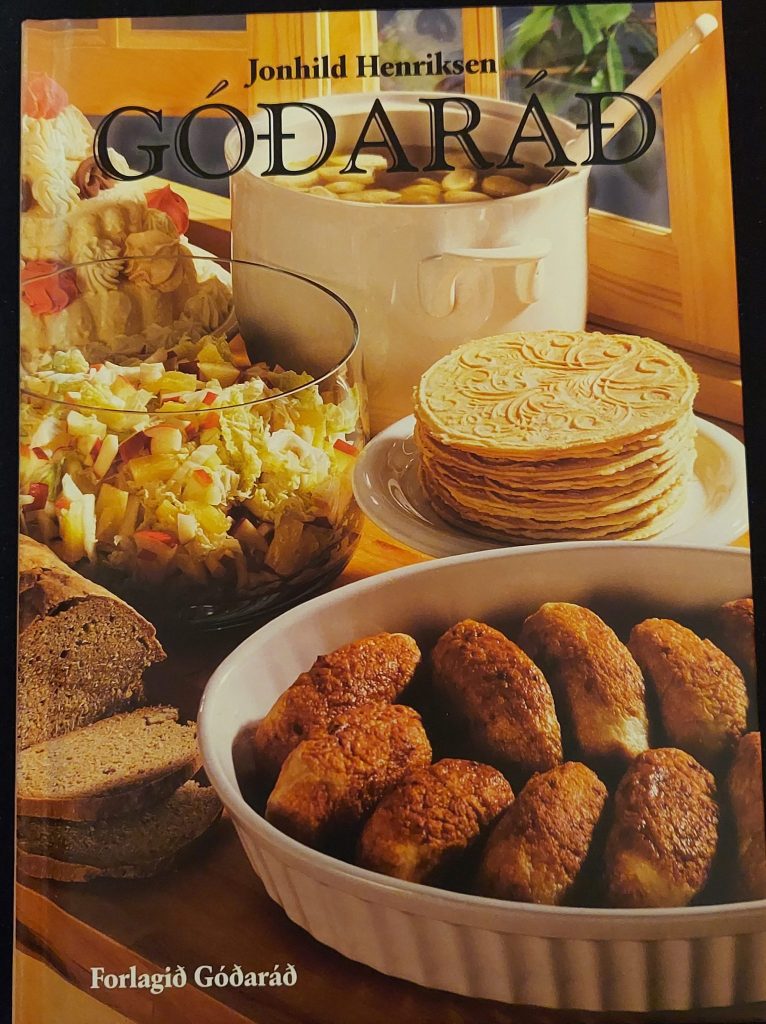
I was able to check out two other installations before they closed: Muted Tefillah Interactive Video by Laura Puras (individually submitted from USA) and Music for Strings & Silk by Rosalie Grankull (ISCM-Gotland Section). Muted Tefillah Interactive Video was inside the same concert hall in Tjóðpallur Føroya where we listened to the concert of works set to and inspired by various texts. The audience members are the performers as well as the listeners. I followed the instructions on screen and “performed” the prayer as I contemplated the composer’s intention for the work to be a piece that challenges the transmission of a prayer beyond the usual oral and written traditions.
I moved on to Rosalie Grankull’s Music for Strings & Silk, which was installed inside Perlan, a gallery space adjacent to Reinsaríið. As a keyboard player, I thought this was a very captivating installation, and it was a very tactile one, too! I got to interact with the strings; plucking, sliding, and gently pulling them according to the instructions. I listened carefully to the various sounds ranging from extreme nuance coming from the interaction with the piano strings, to the powerful resonances generated by the electric guitar strings. I enjoyed moving around this installation quite a bit and kept making various sounds.
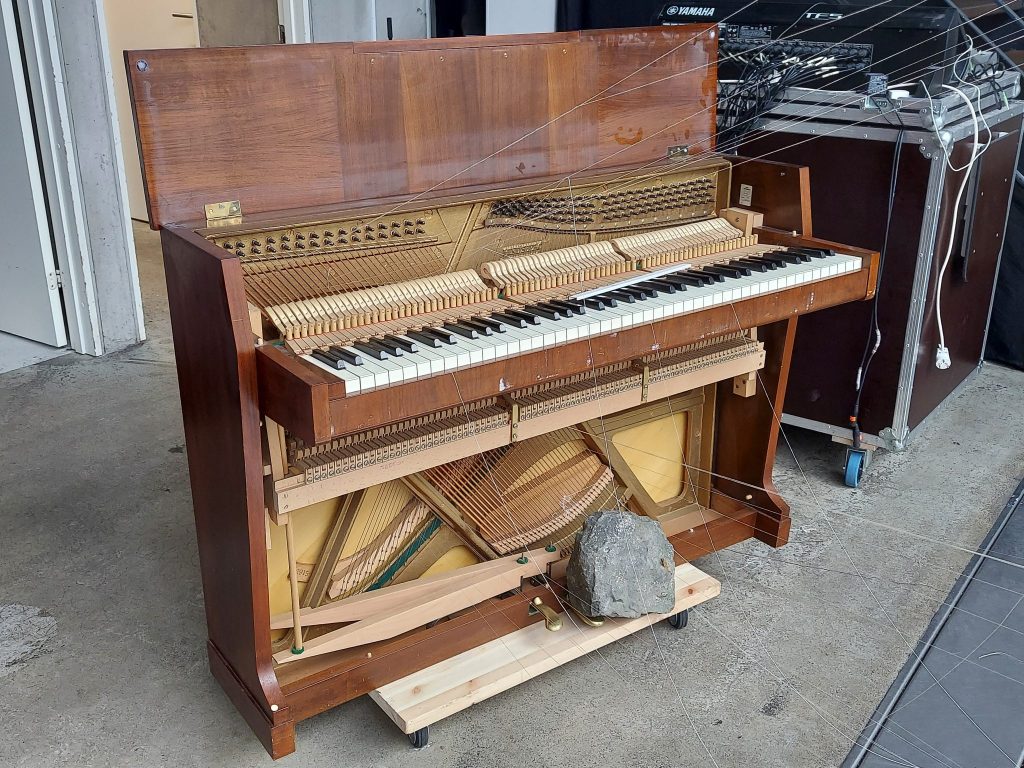
I returned to my role as a listener as I settled into my seat once again at Klingran, this time for another chamber music concert featuring music for horn, trumpet, and piano with electronics, performed by Sören Hermansson (horn) Jákup Tórgarð (piano), Ernst Remmel (trumpet), with Heðin Ziska Davidsen on the electronics. Manuel Rodriguez Valenzuela’s <41> for apprehension machines and electronics was the most fascinating work on the program. What is an apprehension machine anyway? According to the composer, he built and redesigned these machines based on the original model by the Canadian composer Mark Korven. In the composer’s own words: “The ‘apprehension engine’ is basically a resonant wooden body to which are added many different sound objects that are amplified by contact microphones. These amplified sounds are in turn transformed by live digital effects. Some of these sound objects are, for example, a kind of hurdy gurdy, a kind of 3-string electric, a.guitar, a reverb tank, various springs, music boxes, metal rods that bounce in different rhythms, etc.” I learned something new today!
As soon as the concert ended we gathered again onto our buses to travel to the island of Borðoy for the next performance in Klasvík. The island was one of the northern-most islands of the Faroe Islands, and it was cold and windy when we arrived. I was hoping to get closer to the waters to try to see the town around the stunning inlet of the fjord (as I saw on the postcards and pictures on the internet), but alas, it was not meant to be. Instead, we gathered inside Varpið, a new cultural destination in the town, first for a much-needed warming cup of tea, then to a bigger space on the ground floor for our welcoming dinner reception. More speeches and more delicious fish soup followed. (I gotta learn how to make this soup.)
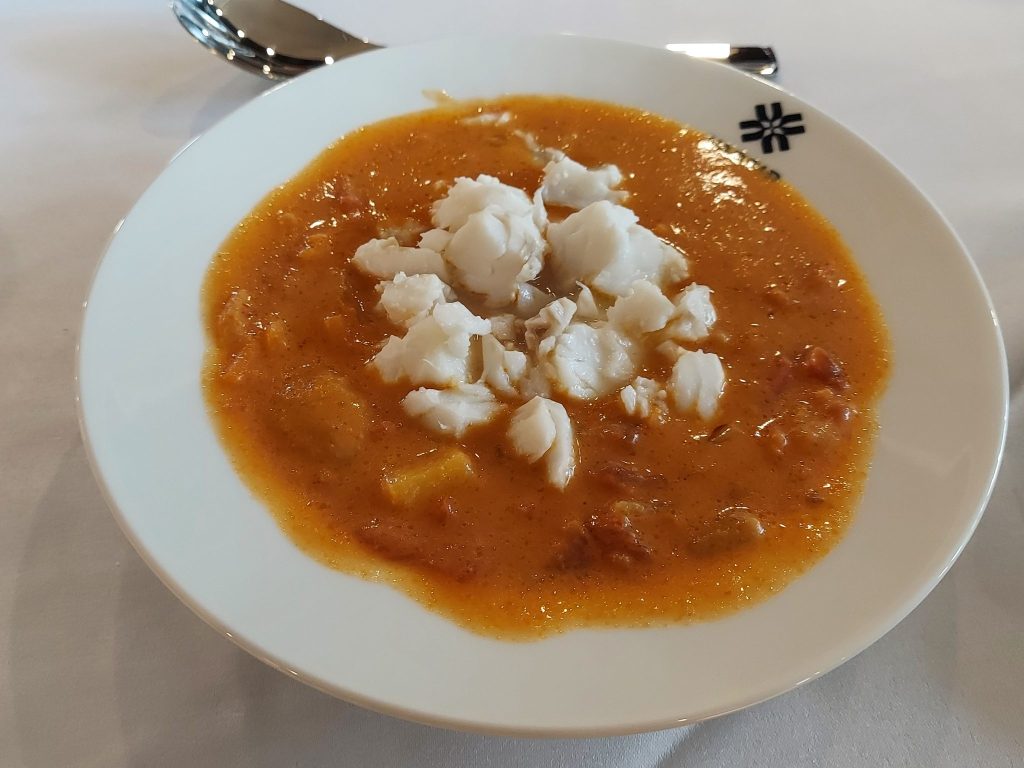
As the dinner came to a close, we went upstairs to find our seats for the next concert of works for chamber orchestra, to be performed by the Faroese group, the Aldubáran Chamber Ensemble, along with their conductor Bernharður Wilkinson. The concert hall was a two-story space that was airy and modern, and I was lucky to have a good vantage point smack in the middle of the front row on the balcony. The concert featured five works, including submissions from the ICSM Icelandic and Chengdu sections, an individually submitted work from Canada, as well as two selections from the Host Section. It was heartwarming to see the locals attending the concert to cheer on the Faroese composer Simona Eivinnsdóttir, who was born and raised in Klasvík. After all, one of music’s biggest roles is its connection to people!
As we passed through the Eysturoyartunnilin one more time, we were driven around the roundabout again for a couple of rounds, enough for everyone to take as many pictures and videos to their hearts’ content. I happily joined in and managed to take a series of photos of the entire installation around the structure. Such a memorable moment.
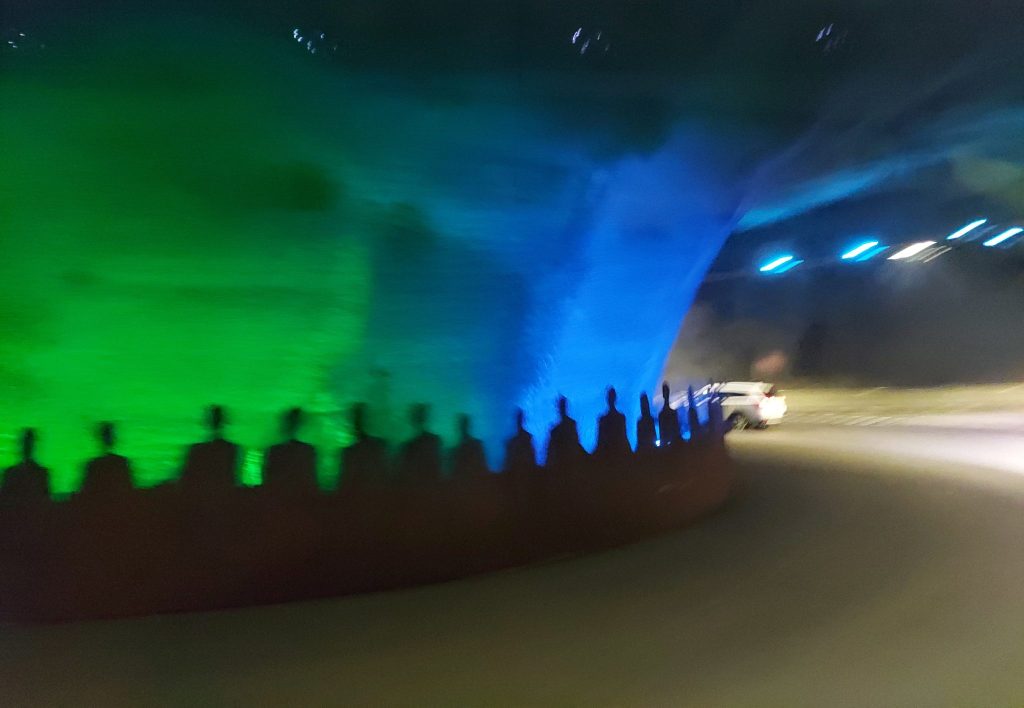
We returned to Tórshavn and promptly found seats at the lobby bar at the Hotel Brandon, as we had to inevitably begin the process of saying goodbye to some of our delegate friends as they prepared to head back home. It is always a sad part of the festival, but we always look forward to the next time that we gather together, maybe at the festival, maybe somewhere else around the world. Enough of the melancholy for now as we still have two more action-packed days to go.
*
June 29 – More Organ, A Metal Sheet, The Big YCA Jury Meeting, and OY Brewing
My second Saturday morning of the festival took me to the Hoyvíkar Kirkja for another concert of organ music performed by Hans Hellsten. Indra Riše’s Procession with Bells (ISCM Latvian Section) was an aptly rousing piece to keep us awake after several days of intense activities. Joined by a horn, the program continued with Páll Sólstein’s Kom andin halgi which was reminiscent of the composer Alan Hovhaness, and offering a more plaintive sound. Three other works followed, written by Kristian Blak, Madeleine Isaksson (ISCM Swedish Section), and Louis Karchin (ISCM USA Section) to wrap up the program.
From music for (largely) solo organ, we traveled back to the Tórshavn Music School, this time for a concert performed by the RWCMD Percussion Quartet from the United Kingdom. The sound world could not be more different as we are now largely in the land of the non-pitched instruments. It is always exciting to see percussion performances though; the energy, the different colors and nuances, and all the cool sounds and rhythms, love them all. The quartet performed 5 of the 6 works: Laura Manolache’s Colour Combinations (ARFA), Manuel Zwerger’s OHNE TITEL (ISCM Austrian Section), ARTISTN by Leandro A. Martin (COSIMTE) for two players on a marimba (with backward-facing mallets), Olof Conéer’s Three Sisters for solo percussion (ISCM Gotland Section), as well as David Biedenbender’s Ferrum for percussion quartet (Michigan Technological University), which I personally quite enjoyed (Okay, true confession time – I always enjoy the music of David Biedenbender. There, I said it.) In the middle of the program, composer Dario Buccino performed his own work, Mi nasco. Per lamiera HN. Nº 1 (individually submitted from Italy). Copies of the score were passed along to the audience, but our eyes and ears became glued to what was actively happening. It was a very physical work where the composer became progressively, ahem, intimate with a life-size steel sheet, complete with highly suggestive movements and sounds. No matter what your thoughts are about this work, it is undeniable that the piece is rather unforgettable.
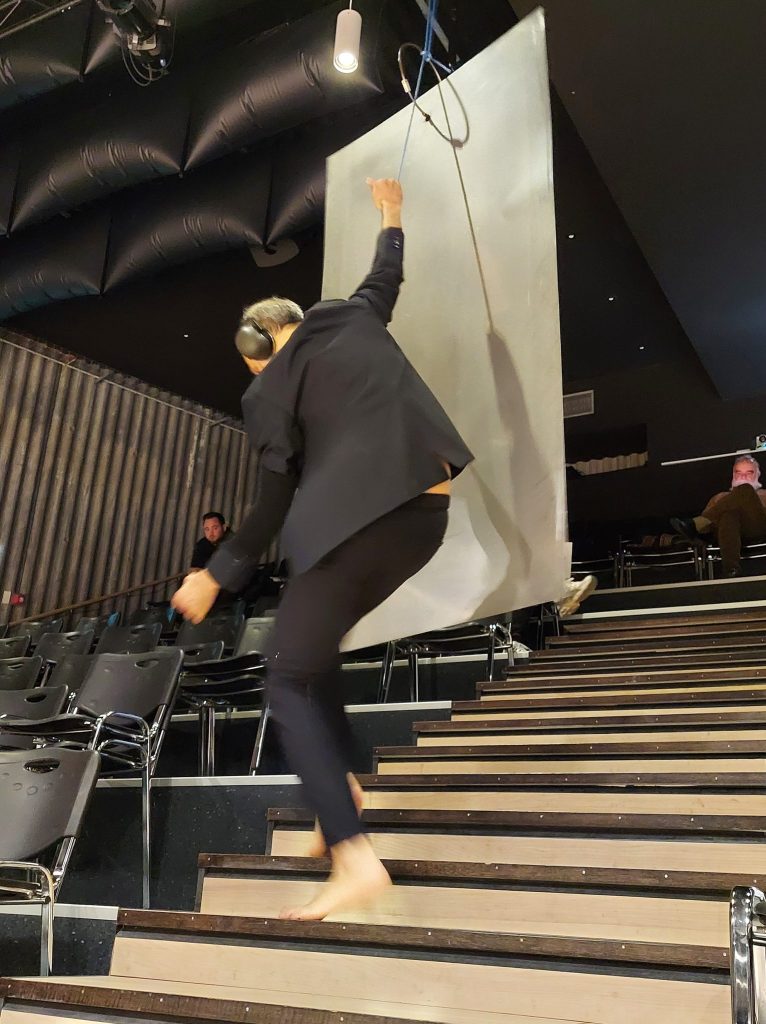
We took a pleasant walk downhill towards the city center of Tórshavn. Although it was a little drizzly, we had all acclimated to the Faroese weather at this point, so we just continued to stroll into the direction we were heading towards, in search of some light fare before the next concert. I was happy to be finally able to enjoy a light meal at the adorable and friendly Paname Cafe. Our cheese and charcuterie board was very delectable too, just the right food to tide us over for the next few hours. It would also be enough to keep me perked up for the final concert at the Nordic House, as well as the big YCA meeting right after.
Before we began the final concert at the Nordic House, featuring works for chamber choir performed by Ars Nova Copenhagen with music director Graham Ross, ISCM President Glenda Keam came to the stage to offer a few rounds of gratitude towards the various local organizers who helped make the 2024 ISCM WNMD such a successful and pleasurable experience.
The music soon followed. The vocal ensemble performed 8 works by Mette Nielsen (ISCM Danish Section), Sarah Rimkus (Michigan Technological University), Rhona Clarke (ISCM Irish Section), Kári Bæk (ISCM WNMD Faroe Islands Section), Levente Gyöngyösi (ISCM Hungarian Section), Tsung- Jen Hsieh (ISCM Taipei Section), James Robinson (individually submitted from the UK), as well as Tag des Jahrs by Kaija Saariaho. Saariaho has been an honorary member of the ISCM since 2012, and it was performed in memory of her passing in 2023 as a closing work to the program. The vocal ensemble gave lovely and convincing performances; I was glad to have heard them live!
While most of our delegates leisurely returned to their respective hotels for a break before the show at the OY Brewing nearby, we YCA judges headed to work, huddling in the same room that we have been using for our various meetings. The meeting would be a big one today as all the eligible YCA works were all presented. It was time for us to share our notes, to tally the final scores, and to select the winner. We gathered all the results, and worked through our list. While we all had our favorites, we were, once again, able to work amicably together as we narrowed down our choices, and eventually selected our winner. That was a joyful moment to be had! We also agreed that we would finalize the speaking order at the award presentation, as we should all have a chance to talk briefly before we announce the lucky winner at the final event on the next evening.
Our final event of the day was a performance of Don’ts for Dancers, co-written by Supervisjón and Tróndur Bogason, who also performed the work. But first, we squeezed into our seats in the very crowded but convivial taproom for a scrumptious dinner of pulled pork burgers and French fries, along with our OY beer(s) of choice to wash down the food. The atmosphere was festive, but our fatigue was finally catching up on us after an exceptionally busy day. We all said our “see you tomorrow” as we returned to the hotel, only to find ourselves going back to the lobby bar for a round of night cap as we bid farewell to a few more friends who were departing the next morning. Ah, one more day to go…
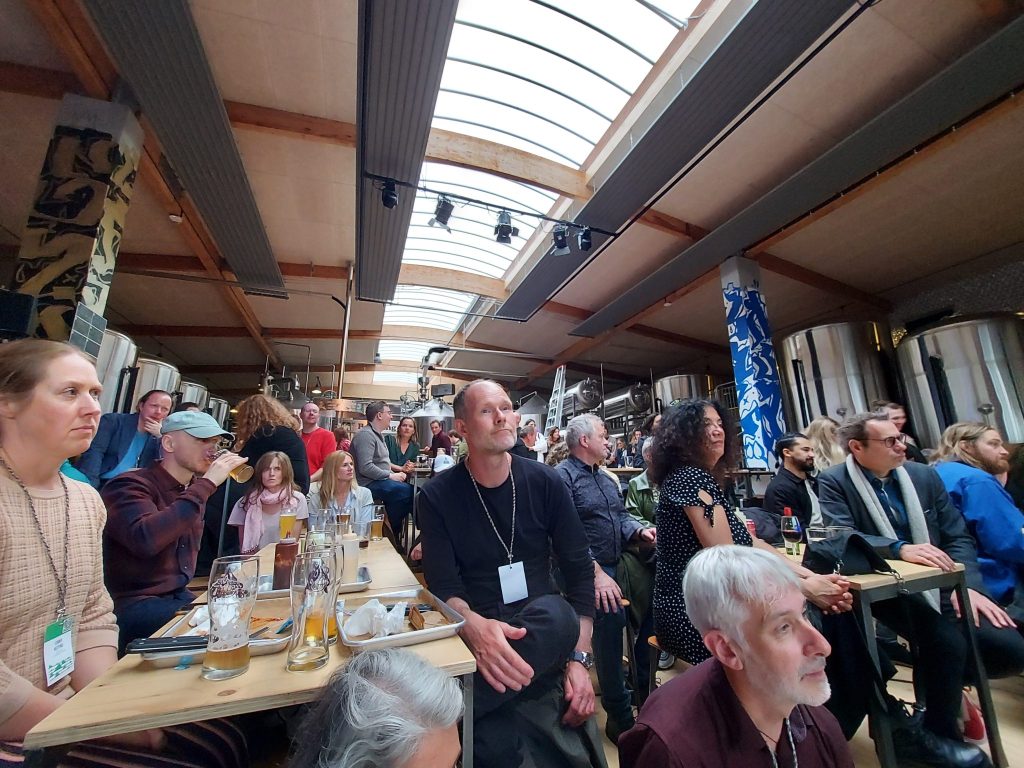
*
June 30 – A Boat Ride to Suðuroy, SALT, and the Unveiling of the 2024 ISCM WNMD YCA Winner!
We received strict instructions to be on time for our ferry to Suðuroy, a two-hour ride to the Southernmost island of the Faroe Islands, so we didn’t linger at breakfast and as soon as we were done we started our trek downhill towards the harbor for our boat ride. We were supremely lucky to have the most beautiful weather as we set sail. I am talking about the sun, gentle clouds, and blue skies.
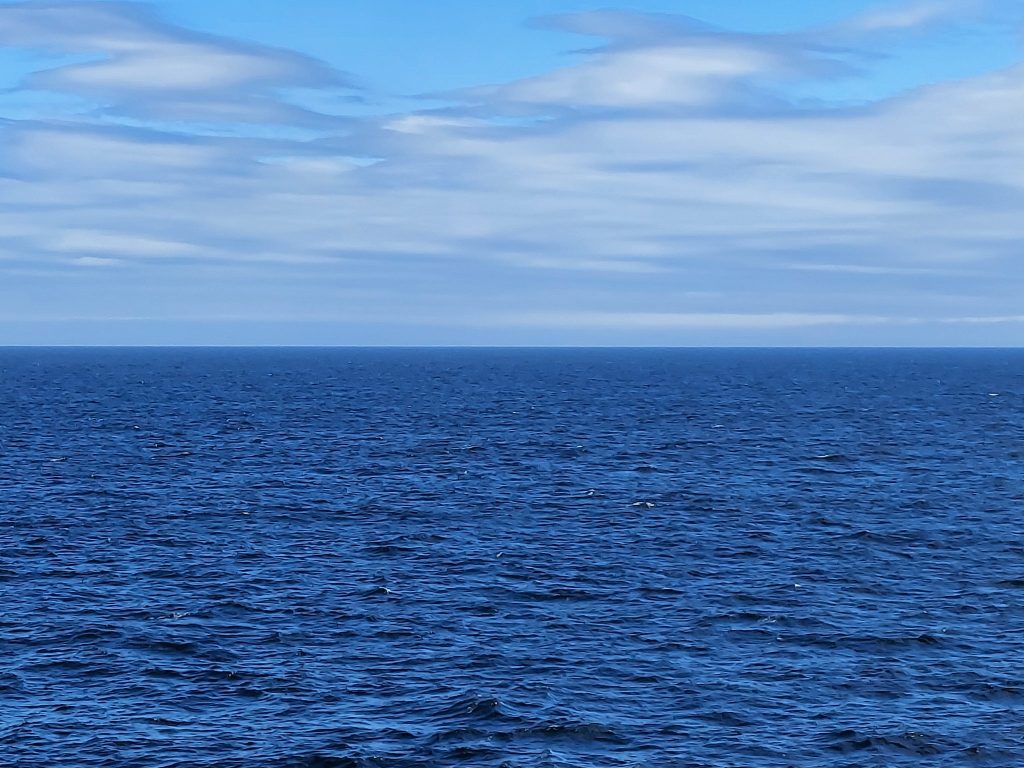
Of course, my phone camera worked overtime trying to capture the scenic views of the fjords and clear blue water. What a gorgeous day for another excursion! (I was also adamant to break my goose egg; I gotta get a decent sheep photo by hook or by crook.)
We were all happy to be on land after the ride as it had just started to get a bit choppy as we sailed further towards open water. We were directed to board a bus as we traveled to Hvalba for a welcoming seaside concert. As I surveyed the steep way down the hill to the landing, I soon realized that we all needed to walk down in single file along a narrow path. We were walking slowly as the lower we got the more treacherous the path became. (I was very determined to avoid a face plant at all costs…my mind went to some questionable places of what-if scenarios which I quickly shut down. NOPE.)
A local brass band welcomed us with a short set of music, which was admittedly a little hard to hear sometimes as it was windy and the space was wide open. That all said, it was still a sweet sight as the local musicians serenaded us against a backdrop of an island which we were told was only inhabited by a whole bunch of sheep that are tended by local from other islanders who visit them just a handful of times per year. Interesting.
As we applauded the musicians and made our way carefully back up to our bus, we headed towards our next concert of 6 works by string quartet, performed by the Aldubáran String Quartet. The venue, SALT – Sound Art & Live Theatre, was named after its previous incarnation, a salt barn. It was renovated and turned into a cultural space for the island of Suðuroy. The standout piece of this concert was Ig Henneman’s Outside the Rain Has Stopped (ISCM Netherlands Section), bar none.
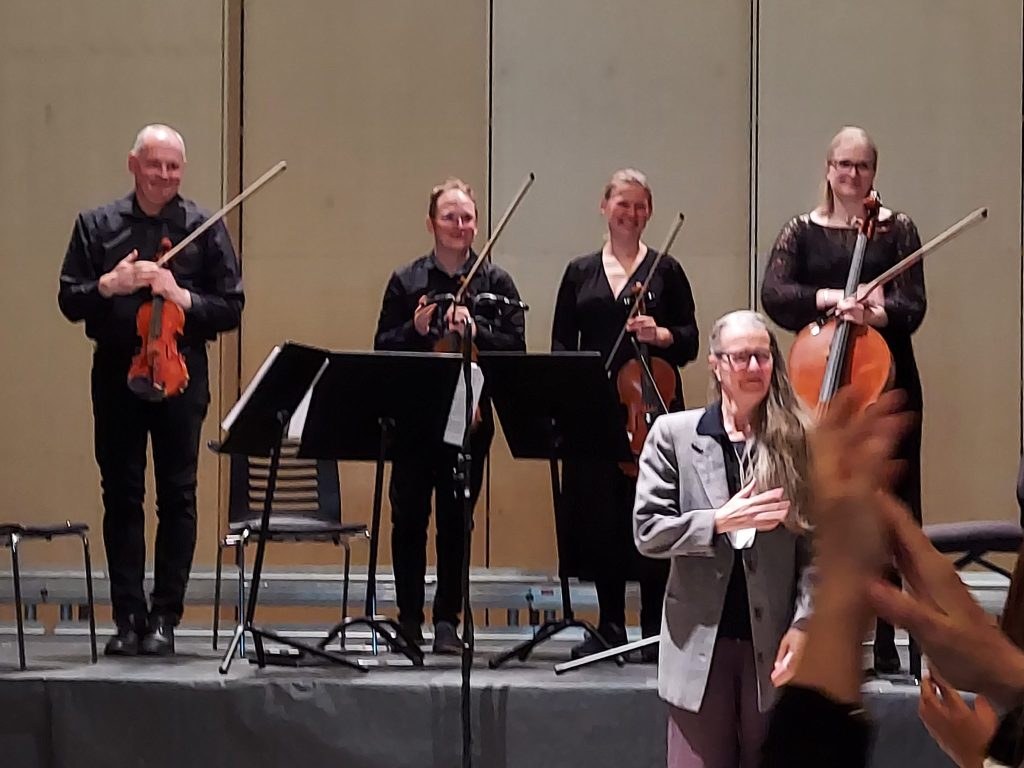
We also heard works by Mao Zhu (ISCM Chengdu Section), Yvet Soul Zisso (ISCM Israel Section), Tomaž Svete (ISCM Slovenian Section), Eli Tausen á Lava (ISCM Faroese Section), as well as a work submitted individually from Brazil by Harry Crowl.
*
We had only a short window to get back to our ferry, so we were all focused towards the ferry pier as we left the venue. Well, dear readers, I finally scored along the way back to the boat: A proper sheep photo!
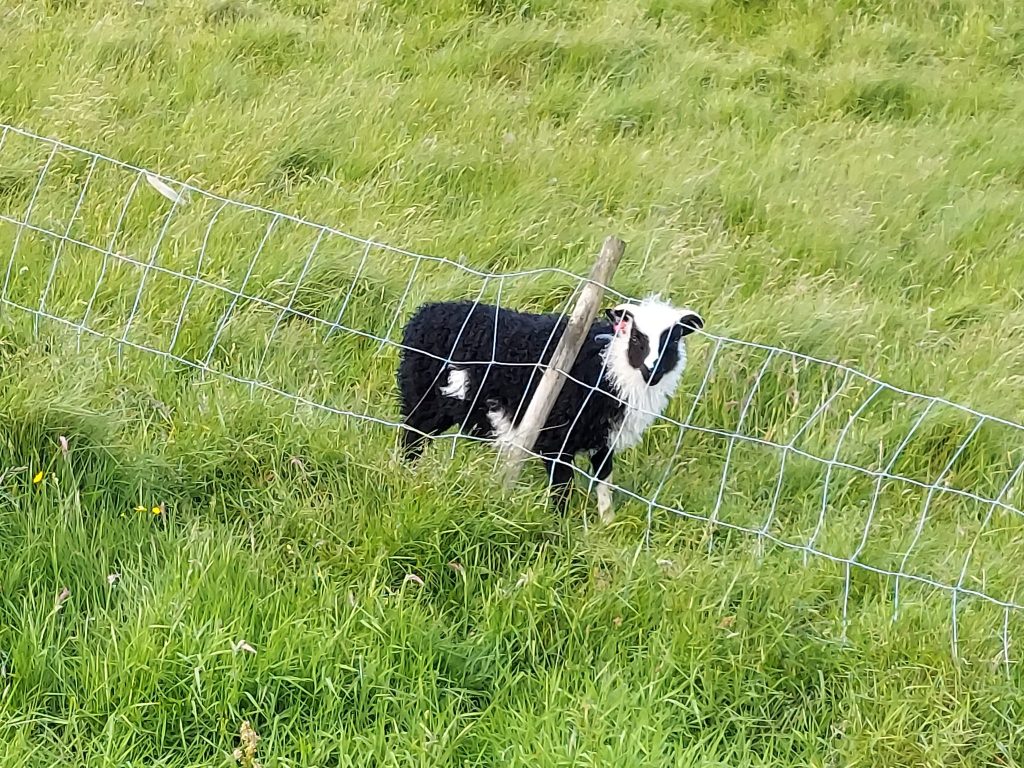
It was just a few more hours before we announced our YCA winner. We three judges found a quiet(er) table on the boat as we finalized our little speech and our order of presentation, and once again reiterated what a fabulous experience we all had working together. A round of cheers was in merry order as we raised our glasses for a group congratulation toast.
We arrived at the Hotel Hafnia Panorama Suite with a bit of time to rest up before the final event of the day. The weather continued to be lovely, and the panoramic view was spectacular with all the lovely colors and crystal blue skies in the evening’s slowly setting sun.
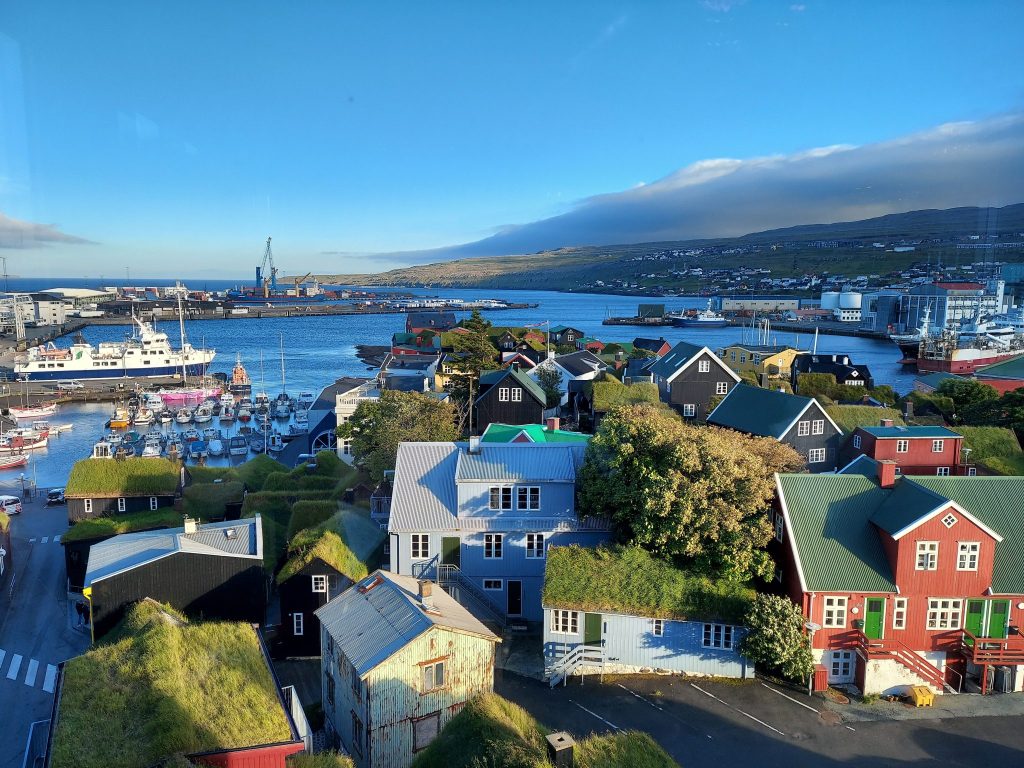
What a perfect background for our upcoming important announcement! For the music portion of the evening, Ig Henneman and her performance partner, Ab Baars (Duo Baars-Henneman) performed a set of improvisations, followed by Heðin Ziska Davidsen as he returned to the stage with his band one more time for a set of instrumental improvisations based on Faroese vocal practices. But before all that, it was time to unveil the winner of the YCA 2024 edition. Drumroll please! Magnus Bunnskog, our democratically elected award announcer of our trio, declared Samuel Hvozdík’s Magma for solo organ (ISCM Slovak Section) was the winner of the Young Composer Award. We were all impressed by the innovative and fresh sounds written for the organ in his work, and it was ultimately a unanimous decision. Let’s have a big round of applause for Samuel Hvozdík!
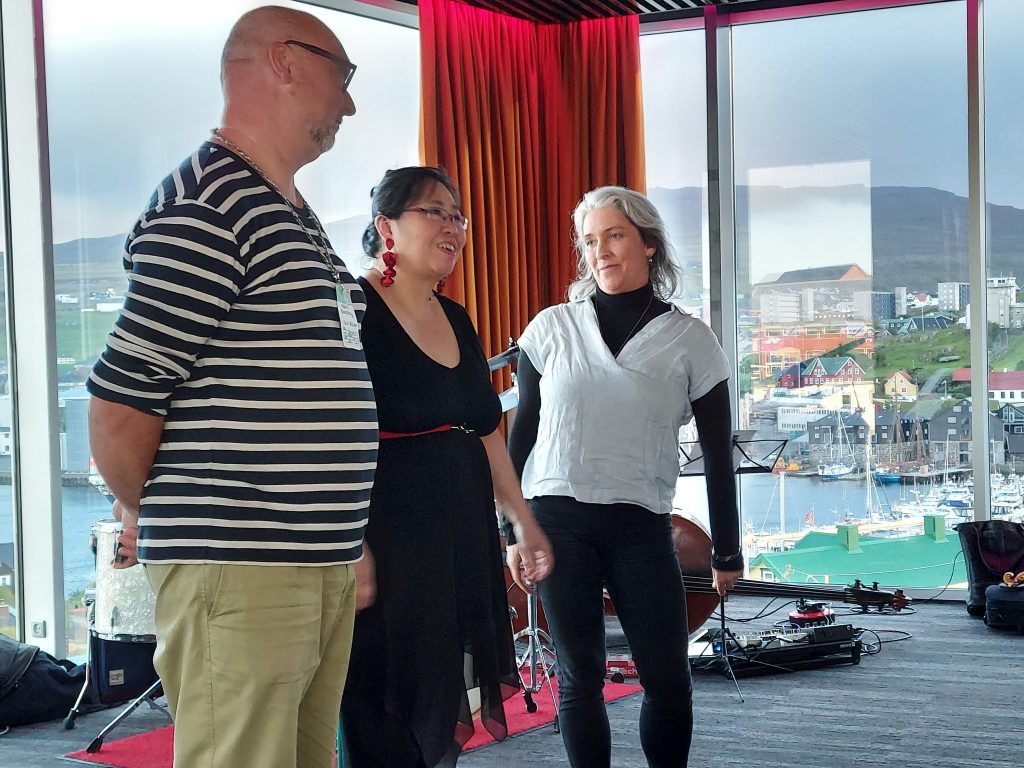
The end of the concert also marked the end of the festival for me, as we were set to return to New York City the next day. Shoutouts again to our dear friends on the intrepid artistic and festival team of the ISCM Faroese Section, who were not only fantastic hosts but were formidable composers and performers as well. We were grateful for their hospitality and warm friendship, and we all look forward to meeting them again. Shoutout also to Lasse Thorning Jæger for the awesome intro to all the videos. It was so cleverly designed! And I would be very remiss not to offer my personal thank yous to the wonderful Sharon Weiss, who not only offered some practical help for all of us, but also shared her delicious Faroese Fish Soup recipe for those of us who love to cook. Here’s my picture of my version of the fish soup for your enjoyment. And, yes, it did look as good as it tasted. See you all in Portugal!
